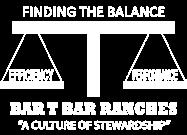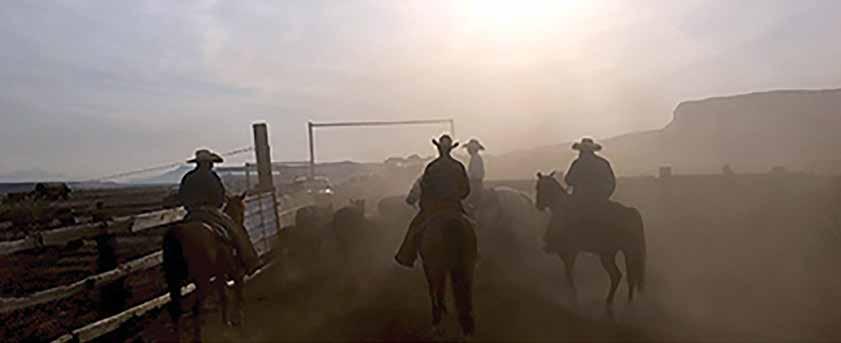








The pick of six bulls from the Wyoming Hereford Ranch’s champion carload from National Western Stock
in Denver in 1938.

Roundup Crew at Hay Lake around 1937. Includes Ernest and Evelyn Chilson, Ernest’s brother Don, and father “Boss” Chilson.






















The pick of six bulls from the Wyoming Hereford Ranch’s champion carload from National Western Stock
in Denver in 1938.

Roundup Crew at Hay Lake around 1937. Includes Ernest and Evelyn Chilson, Ernest’s brother Don, and father “Boss” Chilson.












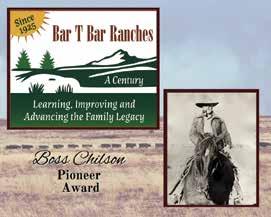
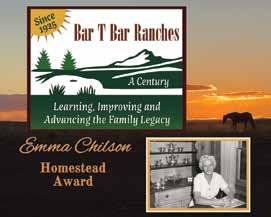

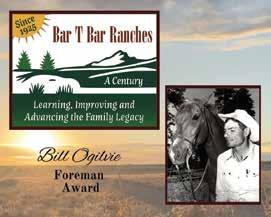
Boss Chilson Pioneer Award >20 years •12.5% Bull Credit
Flying M Ranch, Metzger Family, Flagstaff, AZ
Dugas Ranch, Birkemyer & Teskey Families, Mayer, AZ
Quarter Circle U Ranch, Backus and Doyle Families, Gilbert, AZ
Emma Chilson Homestead Award >15 years •10% Bull Credit
X4 Cattle Company, Griffin Family, Globe, AZ
Moorman Ranch, Jack Neal Family, Ely, NV
Perkins Ranch Inc., Perkins Family, Chino Valley, AZ
Major Cattle Co., Major Family, Chino Valley, AZ
Ray Guyman Family, Huntington, UT
Heiden Land and Cattle, Heiden Family, Buckeye, AZ
Chilson Trailblazer Award >10 years •7.5% Bull Credit
Diamond G Ranch,Gutierrez Family, Grants, NM
R&R Agro Tech, Dr. Ray Rodriguez, Tucson, AZ
V-V Ranch, University of AZ, Rimrock, AZ
Orme Ranch, Orme Family, Mayer, AZ
Muleshoe X Cattle, Randall Family, Pine, AZ
Maho Family, Polacca, AZ
Wilkinson Gelbvieh Ranch, Wilkinson Family, Model, CO
XX Cattle Company, Armer Family, Vail, AZ
Ute Mountain Farm and Ranch, Towaoc, CO
Mathis Family, Price, UT
Navakuku Family, Polacca, AZ
Aja Family, Buckeye, AZ
years •5% Bull Credit
Oak Tree Land & Cattle, Tim & Barbara Jackson, Tucson, AZ
O’Haco Ranch, O’Haco Family, Winslow, AZ
Webb Ranches, Webb Family, Globe & Skull Valley, AZ
Crossline Ranch, Giesler Family, Springerville, AZ
Hanson Ranch, Hanson Family, Joseph City, AZ
Jon Cooper Family, San Lucas, CA
Jon Nielson Family, Dove Creek, CO
Almida Land & Cattle, Gipe & Verner Families, Paulden, AZ
Rancho Grande, Fimbres Family, Carbo Sonora, Mexico
Legacy Ranch, Flake Family, Snowflake, AZ
McNelly Ranches, McNelly Family, Williams, AZ
J Albert Brown Ranch, Brown Family, St. Johns, AZ
J-S Ranches, Sutphin Family, Lamar, CO
Robinson Cattle Co., Joe Robinson, Green Valley, AZ
Rockin Y, Harry Yazzie Family, Tuba City, AZ
Barker Ranch, Barker Family, Dell City, TX
Black Elk Ranch, Stuart Avery, Winnemmuca, NV
Mike Christenson, Cleveland, UT
CJSD Gelbvieh, Diehl Family, Bradford, OH
Marks Ranch, Marks Family, Blue, AZ
Warnock Ranches, Warnock Family, Maupin, OR
McComb Family, Cortez, CO
Schlegel Family, Burns, CO


Friday, April 11 • 9 a.m. PDT • Crater Ranch Headquarters • Winslow, AZ.
9:00 a.m. Trade Show and Bull Viewing Begins
12 noon Lunch
2:00 p.m. Speaker Presentations
Jim Sprinkle, Ph.D. • University of Idaho
Grazing Behavior of Efficient and Inefficient Cattle on Rangeland
Dan Bell, ZZ Cattle Co. • Drew McGibbon, Santa Rita Ranch
The Future of Virtual Fence
Dave Daley, Ph.D. • Public Lands Council Board of Directors & 5th Generation California Rancher
The Challenges and Opportunities of Public Land Grazing
Kent Anderson, Ph.D. • Zoetis
The Future of DNA and Economically Relevant Traits
Moderator: Lee Leachman • CEO, Leachman Cattle
5:00 p.m. Social with Heavy Hors d’oeuvres
6:00 p.m. Centennial Customer Awards

MANY THANKS TO OUR SPONSORS:
AgWest Farm Credit • Animal Health Express • Arizona Society for Range Management • Yavapai Cowbelles • Elanco • FerAppease • Halter Virtual Fence • Headquarters West • Maid Rite Feeds • Merck • Multimin • RanchBot • Superior Livestock • Sweet Pro • Western Video • Zoetis • Producers Livestock Az

Jim Sprinkle, Ph.D., was raised on a livestock farm in Southwestern VA, received an associate’s degree in horsemanship and stable management at Ricks College in 1980. He later received a bachelor’s degree in animal science from Brigham Young University, a master’s degree in animal science from Montana State University (MSU) and a doctorate in animal nutrition from Texas A & M University (TAMU).
His research at both MSU and TAMU was with range cattle and encompassed range animal nutrition and forage intake, grazing behavior, and physiological and genetic adaptations to a range environment. Sprinkle was employed as an area Extension agent in animal sciences, regional livestock specialist and county Extension director by the University of Arizona for more than 20 years before retiring in 2015.
In 2015, Sprinkle started work as a statewide Extension beef specialist with the University of Idaho. He has a 25 percent research and 70 percent Extension appointment with an emphasis in beef cattle range nutrition. His major research emphasis is in grazing behavior, forage intake, beef cattle efficiency and range animal nutrition. He also participates in rangeland monitoring and adaptive management Extension programming.
He is married to the former Barbara Joan Duell who grew up on a cattle ranch in Alberta, Canada. Jim and Barbara have seven children and 13 grandchildren.

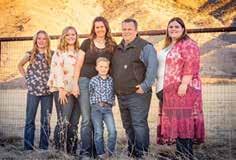
Born and raised in ranching south of Tucson, Drew McGibbon studied animal science at Colorado State University and the La Trobe University in Australia and attended graduate school at the University of Arizona. His family has worked with the University of Arizona on arid lands livestock research on the Santa Rita Experimental Range (SRER) for almost 60 years. Both sides of McGibbon’s family ranch on three operations in Arizona and New Mexico, where they run primarily Red Angus cattle (Arizona and New Mexico) and sheep (New Mexico). McGibbon is the proud father of four amazing kids, is married to “my amazing wife of 26 years who is far smarter than I” and states that there is no greater blessing than being a father, husband and rancher.
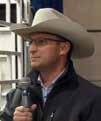


A third-generation rancher, Dan Graham Bell currently serves as president of the ZZ Cattle Corporation of Nogales, AZ. Bell’s family has been working the same piece of country along the border since 1938. Over the years the operation has expanded to approximately 50 sections with nearly 10 miles bordering Mexico.
Bell graduated from the University of Arizona in 1995 with a bachelor’s degree in renewable natural resources emphasizing range management. He has been a member of the College of Agriculture & Life Science Alumni Council and has served as treasurer and president of University of Arizona’s Ag 100 Council.
Bell has been actively involved in the cattle industry, serving as president for both the Southern Arizona Cattlemen’s Protective Association and the Arizona Cattle Growers’ Association. He currently serves on the board of directors of the Arizona Farm and Ranch Group.
He has also served as a member of the Arizona Department of Agriculture’s Advisory Council and on the board of directors for the Pima County Farm Bureau. He is also on the board of directors for the Center for Rural Leadership (Project Central).
Kent Andersen, Ph.D., was raised on a diversified livestock and farming operation in central Nebraska. Andersen earned his bachelor’s degree from the University of Nebraska in 1985 and his master’s and doctoral degrees from Colorado State University in 1987 and 1990, respectively. Following graduation, Andersen worked for the North American Limousin Foundation where he served as director of education and research from 1990 to 1999 and executive vice president from 2000 to 2009. In his position with Zoetis, Andersen serves as director of global beef genetic technical services, precision animal health. Andersen remains active in his family’s commercial cow-calf operation in Nebraska. He and his wife, Wendy, reside in Windsor, Colo., and their daughter, Claire, attends the University of Nebraska-Lincoln.
Bell served on the Governor’s Rangeland Technical Advisory Council established by Arizona Gov. Jane Dee Hull, with the charge of reviewing rangeland models for estimating carrying capacity used by the US Forest Service on Arizona forests.
Bell has been married to his wife Roxanne for 32 years. The couple has three children: Katie, Matt and Aidan.

Dave Daley, Ph.D., earned his master’s and doctoral degrees in animal science from Colorado State University after completing his bachelor’s degree at California State University, Chico.
A native Californian, Daley is a fifthgeneration cattle producer from Butte County, running the family ranch near Oroville alongside his son, Kyle. Daley is also a leader in California’s beef industry, holding leadership positions on the local, state and national levels. Daley is a professor emeritus at CSU, Chico. For more than 30 years he served as faculty in multiple roles, including professor, department chair, associate dean and interim dean. He also served as the director of the Agricultural Teaching and Research Center (University Farm complex). Daley taught a wide array of courses, primarily in animal sciences, but also courses focusing on agricultural issues that broadly impact society. He has lectured widely on livestock production systems and the connection of agriculture to other societal issues.
Daley’s family has had cattle on US Forest Service grazing permits in the Plumas National Forest for generations, making him well versed in the issues public lands ranchers face and passionate about preserving public lands grazing, leading him to serve in multiple leadership positions. He is currently chair of the California Public Lands Council, chair of the Public Lands Council Forest Service Committee and past chair of the National Cattlemen’s Beef Association’s Federal Lands Committee.
In addition to his public land-related leadership roles, he currently serves as chairmen of the California Cattle Council. Daley is also past president of the California Cattlemen’s Association.

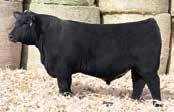
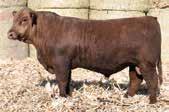
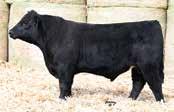
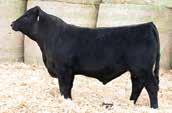
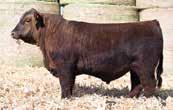

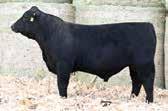

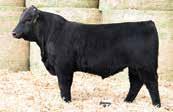
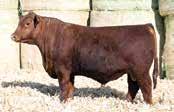
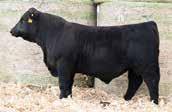


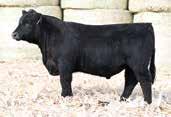
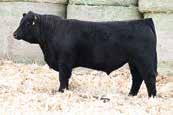
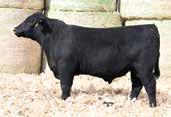


Eric Duarte, Auctioneer .............................................. (541) 891-7863
Dean Fish, Independant. ............................................ (520) 988-8009
Matt Macfarlane, California Cattleman ...................... (916) 803-3113
Jarod Patterson, Western Livestock Journal (208) 312-2386
Eric Drees, Independant (208) 329-4808
Sale Day Phones:
Bob Prosser .............................. (928) 380-5149
Judy Prosser (928) 699-8587
Kristin Hovey (970) 485-0974
Devin Hovey (970) 485-5360
Lee Leachman ........................... (970) 219-8519
Craig Hays ................................. (660) 373-1897
Wade Woodbury ...................... (505) 290-5642
Sam Garcia................................ (520) 456-7804
Spencer Prosser (928) 856-0186
Sale Vet Dr Colin Durham (719) 339-0326
Superior Livestock (800) 422-2117
FRIDAY, April 11th:
• Bull viewing all day
• 9:00 AM Trade show opens
• 12:00 PM Brisket Lunch
• 2:00 PM Field Day Program Starts
• 5:00 PM Social with Heavy Hors d’oeuvres & Entertainment with Franklin Smith in Tradeshow
• 6:00 PM Centennial Customer Awards
SATURDAY, April 12th:
• 11:30 AM Tri-tip lunch by AgWest Farm Credit
• 1:00 PM Sale
Please note that we need a list of your prospective bulls that need a PAP test by April 2nd!
Twin Arrows Casino, 928-856-7200
La Posada Motel in Winslow, 928-289-4366
Best Western Motel in Winslow, 928-289-2960
The Winslow Motel, 928-882-9009
There are numerous motels on the East side of Flagstaff ~ 45 miles.
Free Delivery on bulls to adjoining states at central locations or to your ranch in Arizona. A $75 Discount will be given if your bull is picked up sale day.
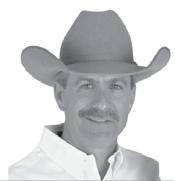
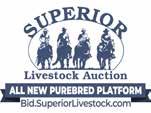

The Supplement Sheet will be available on April 7th, at www.bartbar.com, with ultrasound, frame scores, scrotals and PAP.
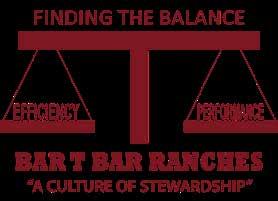
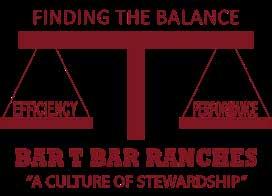
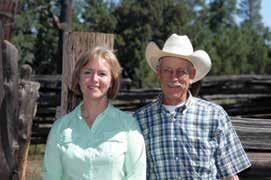
Dear valued friends and customers, This year is a milestone, a century of ranching on the Mogollon Rim in Arizona. This is a humbling opportunity to celebrate! We are recognizing the past, looking to the future, and honoring some of the many customers that helped us get here. We are having a field day on Friday April 11th, the day before the sale. We have an exceptional program featuring Public Lands, DNA testing, Virtual Fencing, & Grazing Behavior of Efficient Cows. A complete schedule is on page two. We have a special evening planned that night, in the trade show, with some great music, followed by awards honoring almost 50 longtime customers. Please JOIN US!
In the 1950’s we started raising registered cattle and we have always been committed to producing the best in cattle genetics that fit this arid and unpredictable environment. Bar T Bar has a long history of using data and sound science in managing our range resource and driving our genetic selection. There are few, if any, range operations that have cattle with the testing and data behind them that we have: feed efficiency, ultrasound, PAP, DNA, and strict fertility standards. This is the most proven predictable range cowherd in the Southwest!
The bulls selling are backed by the most robust multibreed genetic analysis in the industry. $Profit, $Ranch and $Feeder are the best selection tools out there. They provide multi-trait, economically relevant information that makes a difference to your bottom line and keeps your buyers coming back.
All bulls will be Trich tested. Even though there is a PAP EPD in the catalog, they are not all PAP tested. If you need bulls PAP tested, call or send us a list of possible bulls by April 2nd. Bulls can leave sale day. You will get a $75/bull haul credit if you haul. We offer free delivery to Arizona and to central locations in surrounding states.
We want to thank the Leachman Cattle Crew for all their help in developing, testing, marketing, and most importantly for the genetic analysis that helps our program move forward.
We want to thank the 20 sponsors and field day hosts. They are all in this catalog and will be in the Trade Show. Both lunches catered by Babe’s Roundup and the Social on Friday night are all possible because of their generous support! Volume buyer will receive a $2000 value at Ranchbot for Water monitoring devices. There is an excellent selection of industry leading bulls to choose from. Offering over 200 bulls that average
Top 5% $Profit, 10% $Ranch, and 6% $Feeder. There are over 80 Calving Ease bulls, 50 Southern Balancer Influence, both black and red. These bulls are developed to cover the country and maximize the economic return on your genetic investment.
Please join us to learn and have a great time April 11th and 12th.
From all of us here: We would not have made it a century without all of you!
The entire Bar T Bar Family and Crew.


Ranchers,
Despite the dry weather in the Southwest, it’s still one of the best times ever to be in the cow business. Now, more than ever, it pays to have good cattle. To build the best possible herd, you should be using Zoetis Inherit Select to pick your replacements. You should also be buying the best bulls that you can afford.
Good cattle are cattle that make you more money than do average or poor cattle. This really comes down to a few simple things:
• Your cows must earn their own living by getting bred and bringing in a good calf year after year.
• Your replacements need to breed up the first time and breed back the 2nd and 3rd times.
• Your feeder cattle need to gain, convert, hang up a heavy carcass, and marble.
The Bar T Bar bull offering will build cows and feeder cattle that check all of these boxes. The Bar T Bar cowherd runs in real world conditions that are as tough or tougher than most commercial herds in the region. Best of all, these bulls are backed by people you can trust.
Whether you are a repeat buyer or a potential first-time buyer, be sure to come early this year to attend the field day on Friday, April 11th. Then study the bulls and stay for the sale!
With over 200 bulls selling, the volume and quality is deeper than ever. The bulls are off the charts on Cow Fertility, $Ranch, and $Profit!
We look forward to seeing you at the Bar T Bar sale in April! Regards,
Lee Leaachman

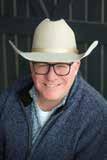
Bull Tags: Each bull is wearing a colored breed tag. Breed tags correspond to the tattoo numbers and are colored as follows:
Yellow= Angus
Yellow w/ underline & + = 80-99% Angus and/or Red Angus
Yellow w/ underline= 75-79% Angus and/or Red Angus
Yellow w/ star= 69-74% Angus and/or Red Angus
Blue w/ underline= 25-49% BrangusXBalancer
Blue w/ underline & star= 8-24% BrangusXBalancer
Green=Balancer
Green w/ underline= 69-86% Gelbvieh
Purple w/ underline= 25-49% BeefmasterXBalancer
Purple w/ underline & star= 8-24% BeefmasterXBalancer
White= 50% SimmentalXBalancer
White w/ underline= 25-49% SimmentalXBalancer
White w/underline & star= 13-24% SimmentalXBalancer
Pink= 50% Santa GertrudisXBalancer
Pink w/ underline= 25-49% S. GertXBalancer
Pink w/underline & star= 8-24% S. GertXBalancer
Turquoise= 50% SenepolXBalancer
Red w/ underline= Hybrid (anything that is less than 25% GV and 25% AN/AR)
Clipped corner on tag represents 3-7% American Breeds

The $Profit® index stands as one of the most innovative and effective tools in modern beef production. Designed to help cattle producers maximize their profitability while improving the efficiency of their herds, the $Profit® index has gained recognition across the beef industry as a game-changing resource. By focusing on longterm sustainability and optimizing genetic potential, The $Profit® system empowers producers to make informed decisions that benefit both their bottom line and the future of the beef industry as a whole.
At its core, the $Profit® index is a genetic selection tool that calculates the expected profitability of beef cattle based on specific genetic traits. It is a comprehensive program that goes beyond the typical focus on individual traits like weight gain or carcass quality and instead integrates a range of factors that affect overall production costs and returns. The system evaluates 22 traits such as growth rates, feed efficiency, reproductive success, and carcass merit, assigning each animal a profitability score that reflects its overall potential for long-term profitability.
In the cattle business, you have to balance all of the traits that impact profitability. This is nearly impossible for anyone to do without understanding the tradeoffs and economic impact of each trait. Simply put, $Profit® does this work for you. By selecting for $Profit®, your cowherd will become more profitable (Cows that Work) and your feeder calves will make more money (Steers that Pay).
The $Profit® index utilizes a powerful algorithm to consider the various inputs that contribute to profit, including both direct and indirect costs associated with production.
This allows beef producers to select animals that not only perform well in traditional areas, such as
weaning weights or ribeye area, but also in more complex aspects like feed efficiency and herd longevity. As a result, the program offers a more holistic view of genetic potential and provides a roadmap for selecting the bulls and cows that will yield the best financial outcomes.
The $Profit® score is calculated by taking into account a variety of economic factors. These include:
Reproductive Performance: Since the production of each calf is a major source of income, reproductive efficiency is critical. Bulls that produce cows with higher reproductive performance contribute to the overall profitability of the herd by ensuring higher calf crop percentages.
Longevity and Durability: Cows that live longer and continue to produce calves effectively contribute to long-term profits, reducing replacement and depreciation costs for herds.
Feedlot Performance: The $Profit® system incorporates expected performance data for animals as they enter feedlots, taking into account how efficiently they will gain weight and how well they will grade once processed.
Carcass Merit: Factors like carcass weight, marbling, ribeye size, and yield grade are all considered to predict how well the animal will perform in the marketplace. Higher carcass quality leads to higher premiums at the packing plant, increasing profitability.
$Profit® is generated from a combination of industry standards, genomic testing, and performance records from Leachman Cattle and the broader cattle industry. By assigning a dollar value to each trait, the $Profit® score provides a numerical representation of the expected profit an animal can generate across its lifetime.


Beef producers who use high $Profit® bulls from Bar T Bar are investing in the future success and sustainability of their operations. These bulls are specially selected based on their genetic potential to maximize profitability through superior performance in a variety of traits. Here are some reasons why producers should consider using these bulls:
Increased Profit Margins: Bulls with high $Profit® scores contribute to higher-quality offspring that are more efficient in converting feed, grow faster, and produce better carcass quality. These traits all lead to reduced costs and increased returns for producers.
Reduced Production Costs: Feed is one of the largest costs in beef production. Bulls with high feed efficiency can help reduce feed costs by producing more weight per unit of feed. Additionally, selecting for reproductive success and longevity means fewer replacement animals are needed, reducing overall herd management costs.
Adaptability to Market Shifts: The $Profit® index helps producers select bulls that are not only profitable in the present but are also adaptable to future market trends. Whether it’s responding to changing consumer preferences for beef quality or meeting sustainability demands, high $Profit® bulls are a smart investment for navigating future industry challenges.
The $Profit® index is essential to the future of the beef industry because it helps producers to adopt more sustainable and efficient practices. As the global population grows and demand for beef increases, the industry must find ways to meet that demand while reducing resource use and maintaining profitability.
By using genetic selection tools like the $Profit® index, beef producers can improve the efficiency of their operations. The focus on feed efficiency, reproductive success, and animal longevity helps produce more beef with fewer resources, which is crucial as the industry faces pressure to produce sustainably in a world of limited resources.
Moreover, the system helps producers align their operations with consumer expectations for highquality, responsibly produced beef. By selecting for superior carcass merit and growth efficiency, producers can meet market demands for premium beef while improving their bottom line.
The $Profit® index is an invaluable tool for modern beef producers who want to maximize profitability and sustainability. By choosing high $Profit® bulls, producers can improve herd performance, reduce costs, and contribute to the long-term health of the beef industry. The system offers a clear path forward in an increasingly competitive and resourceconscious market, ensuring that the beef industry remains strong and profitable for generations to come.

The $Ranch® index represents a groundbreaking approach to improving your cow herd. No other index builds cows that excel at all of the drivers of cowherd profitability. $Ranch® will reduce cow feed intake, increase cow fertility and longevity, and increase weaning weights. The $Ranch® index stands as a strategic tool that helps producers optimize their herds for long-term success. By focusing on ranch-level profitability, this system is designed to help cattlemen and women produce better replacement females.
The $Ranch® index is a comprehensive genetic evaluation tool that helps beef producers select bulls that will maximize the profitability and sustainability of their cowherd. The system uses a robust economic model that integrates both the direct and indirect factors that influence the profitability of a cow/calf operation that sells calves at weaning. These include feed costs, reproductive performance, longevity and calf weaning weight. By taking all of these into account, the $Ranch® index calculates a dollar value for each cow that reflects its annual contribution to the overall profitability of a ranch. Herds that use $Ranch® will improve the profitability of their cowherd.
The $Ranch® score is derived from an intricate calculation that factors in a wide range of economic and biological variables. $Ranch predicts relative profit per cow on the daughters of a bull. In simple terms, higher $Ranch® bulls will generate cows that make more money each year. The index considers:
Cow Size and Feed Requirements: The $Ranch® estimates a cow’s annual feed cost using both the cow’s size and its feed intake predictions. Selection for $Ranch® will reduce per cow feed requirements. This will allow both heavier stocking rates and reduced supplemental feed per cow.
Reproductive Performance: Fertility is #1 driver of $Ranch®. The Cow Fertility EPD predicts the number of calves that a bull’s daughter will have in her lifetime. Ultimately, higher Cow Fertility herds will have higher calf crop percentages and lower replacement rates. This positively impacts revenue per cow exposed to the bull and also reduces the depreciation cost per calf. The combined impact on increased revenue and reduced depreciation make reproduction the most important single trait to cow/ calf operations that sell calves at weaning.
Maternal Weaning Weight: The $Ranch® index favors cows that wean bigger calves. However, the impact of weaning weight is less significant that either cow feed cost or reproduction. Nonetheless, selection for $Ranch® will increase herd weaning weights over time.
By evaluating these various factors, the $Ranch® index provides a profitability score that reflects the expected long-term success of a cow. This enables producers to select bulls that will make more profitable cowherds.


The $Ranch® will help producers change the trajectory of their cowherds. The 40-year pursuit of increased growth rates has built cows that are too big and eat too much. This has made it increasingly difficult to generate high calf crop percentages. It has also reduced longevity and driven up supplemental feed costs.
The future of profitable cow/calf operations will be to find the females that are more efficient with higher fertility and longevity. By using high $Ranch® bulls, herds will generate more cows that make it to nine years of age by producing a calf every year. In an era of changing market dynamics, ranches that utilize this program will be well-positioned for future success.
The $Ranch® index is an essential tool for modern beef producers who are looking to optimize their operations for profitability and sustainability.
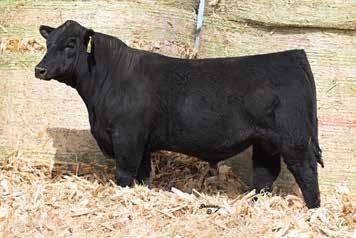
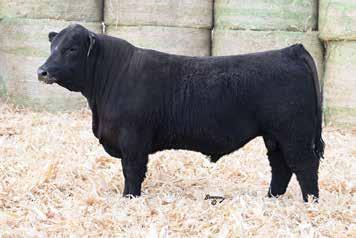
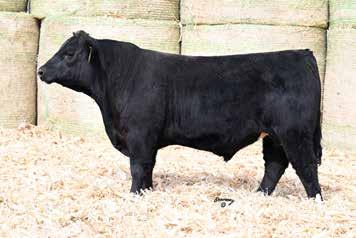

The $Feeder® Index is an innovative genetic evaluation tool that focuses on maximizing the profitability of cattle once they enter the feedlot. With the increasing demand for high-quality beef and ever-tightening margins in the industry, it’s more important than ever for beef producers to focus on the entire production cycle. From conception to the feedlot, the $Feeder® index provides a clear, data-driven way to select genetics that will yield the highest returns for producers at the feedlot level. By optimizing cattle performance in terms of feed efficiency, weight gain, and carcass quality, the index ensures that feeder cattle will be more valuable and generate more profit.
The $Feeder® index is a genetic selection tool designed to enhance the performance of cattle once they enter the feedlot phase of production. It calculates the potential profitability of cattle by evaluating a range of traits that influence how well they will perform in the feedlot. These traits include feed conversion, growth rates, and carcass traits like marbling, ribeye size, and yield grade. The goal is to select bulls whose genetics will produce feeder calves that are efficient, fast-growing, and highyielding, thus maximizing returns during the feedlot phase.
Unlike traditional genetic programs that may focus solely on individual traits, the $Feeder® index combines various factors into a comprehensive score that provides producers with an accurate, bottomline-focused metric for evaluating bulls. This ensures that each animal’s contribution to profitability is fully understood, allowing producers to make smarter breeding decisions for optimal feedlot outcomes.
The $Feeder® score is calculated using a combination of genetic factors that are proven to impact the performance of cattle in the feedlot. The primary factors included in the $Feeder® index calculation are:
Feed Efficiency: This is one of the most critical components in the feedlot phase. Cattle that convert feed into weight gain efficiently cost less to feed and require less time to reach market weight. Bulls that pass on genes for high feed efficiency can significantly reduce overall feed costs, which make up a large portion of the feedlot’s expenses.
Average Daily Gain (ADG): Cattle that grow faster are more profitable because they reach market weight sooner, reducing feed costs and labor. The $Feeder® index calculates how quickly an animal can gain weight based on its genetic predisposition for growth.
Carcass Quality: The $Feeder® index also takes into account marbling score and how it will impact grid premiums. In particular, the index targets the production of higher quantities of Prime and high Choice. Higher marbling carcasses are highly desired by consumers and packers, ensuring the cattle generate more premiums.
Fat Cover and Yield Grade: The amount of fat and muscle on an animal influences its market value. A proper balance is essential—too much fat can lower the quality of the carcass, while too little can result in lower yields. The $Feeder® index evaluates these factors to ensure that cattle reach the ideal weight and fat levels for optimal market prices.
Carcass Weight: The goal of all feeder indexes should be to produce carcasses that can reach maximum weights efficiently. This requires having the growth potential to produce 1,000 pound carcasses. High $Feeder® bulls will produce steers that can reach the highest acceptable carcass weights.
By combining these traits, the $Feeder® index assigns a dollar value to each bull based on how likely their offspring will be to perform efficiently and profitably in the feedlot. This provides a clear indication of the economic return producers can expect from selecting a particular bull for their breeding program.


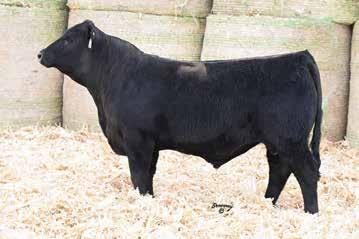
The $Feeder® index is crucial for the future of the beef industry because it helps producers meet the ever-growing demand for high-quality beef while improving feedlot efficiency and overall profitability. $Feeder® will improve feed conversion faster than any other feeder index available in the industry. By utilizing genetics that optimize feedlot performance, producers can help ensure that cattle reach market weight faster, with fewer resources. This contributes to greater overall efficiency in the beef supply chain, from the ranch to the packer. The $Feeder® index also helps producers adapt to shifting market demands by selecting for high carcass quality traits that are in increasing demand by consumers.
The $Feeder® index offers a powerful, economically focused approach to cattle breeding. By selecting high $Feeder® bulls, producers can optimize feedlot performance, reduce costs, and improve profitability. The program not only enhances the financial outcomes of individual ranches but also plays a critical role in ensuring that the beef industry remains competitive and efficient in the face of future challenges.
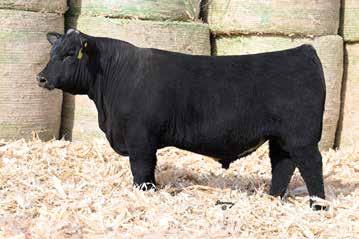
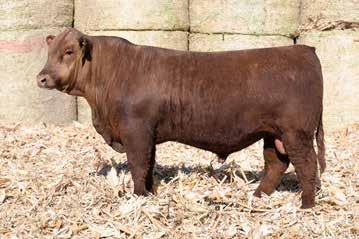

“We operate in country that is high, dry, rocky and relatively wide, much like many others out here in the Southwest. We ask our bulls to perform in temperatures ranging from below zero to well above 100, at altitudes ranging from 4,000 to 9,000 feet and in pastures that are miles wide, so it is always nearly a surprise to see such a good, rich crop of calves resulting from our investment in good bulls from our neighbors the Prossers. We cannot go wrong with their program.”
“We made the decision to change direction with our genetics eight years ago. After 25 years of running exclusively Brangus bulls and letting the environment select our heifers, we had a pretty solid herd of acclimated cows. Our weak link was breed back during dry years, which I felt was linked to mature cow size. That made the choice to start sourcing bulls from Bob and Judy Prosser pretty easy as their philosophy on how to successfully run cows in the arid Southwest aligns with mine.
Since switching to Balancers in 2018 our average mature cow size has dropped 140 pounds while our average weaning weights have remained about the same. Time will tell how that will affect breed back, but I am confident that we are trending in the right direction.”

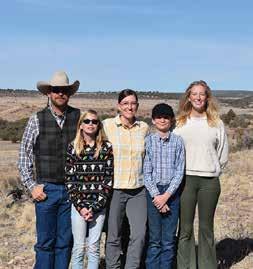
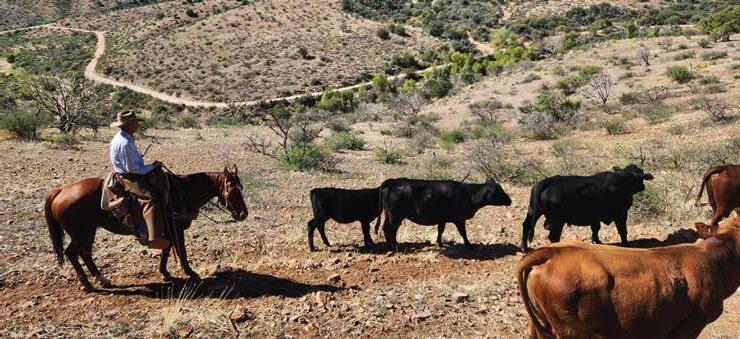
“We started buying Balancer bulls from Bar T Bar around 30 years ago. We were completely destocked in the early 2000s. When we began to rebuild the herd in 2004, we went back to buying our bulls from Bob and Judy. We have some tough country in Gila County and the bulls go right to work and hold up well on our range. They have helped us drastically improve our cow herd through the years. Their calves do well for us as replacement heifers and at the sale barn. We have around a 25 percent higher calf crop percentage and have added more than 75 pounds to our average yearling weights over what was historically here prior.”

“Since 2015 I have been helping my friend, Jesus Fimbres, on his operation in the low desert area of Carbo, Sonora.
Rancho Grande is a family-owned ranch that consists of 50,000 acres divided into five divisions that are all on cleared and plowed land that has been planted with Buffel grass. The ranch owns about 3,600 mother cows. The bulk were straightbred Charolais. Their market was the border trader.
A decision was made to transform the cattle into three terminal sire programs. The black Brangus were mated to Balancer bulls and Angus bulls to improve productivity. Terminally, they will be bred to black bulls or Charolais bulls. The red herd was bred to Senepol, Balancers and Southern Balancers to improve their productivity, and terminally they will be bred to high marbling Charolais bulls. The Charolais were mated to Senepol, Balancer and Southern Balancer bulls to improve size, fertility and adaptability, terminally they will be bred to homo black bulls.
The better end of the Charolais were bred to top 1 percent marbling Charolais bulls and Akaushi, as we could not find a reliable source of high marbling Charolais bulls for sale in the United States.
It did not take us long to realize that we could feed our own cattle and increase the revenue per calf produced at the ranch. We have consistently made more than $250 per head by selling them fed and on the rail rather than by selling them as calves at the border.
At Rancho Grande we keep extensive records on our cattle, which allows us to cull the sub-fertile and poor producer cows.
Rancho Grande is a beautiful ranch with an excellent hunting program. Hunts on trophy Mule, Whitetail deer and Desert Sheep are the mainstay of the operation. A pivot sprinkler system adds a resource to be used to develop heifers and the cow herd in bad years.
Our goal is to produce top-of-the-market, quality animals that can rival their American counterparts. The cow herd will be maintained in semi-desert ranches that are not good for any other kind of agricultural endeavor. We believe our advantage in weather, labor,
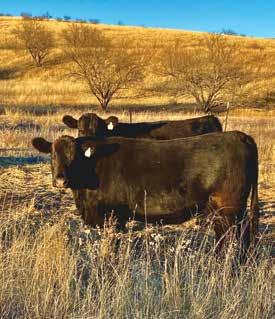
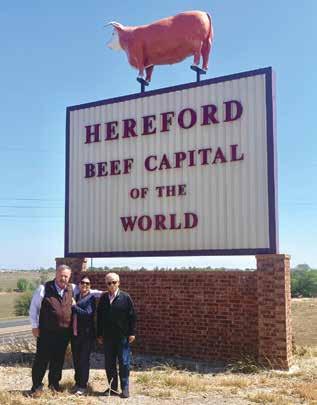
land and other resources will give us a market advantage.
We look at Bar T Bar as our supplier of highly adaptable genetics for both the female side and for the terminal sire side.”
and Rancho Grande, Ray Rodgiquez , Trailblazer Award Recipient and Jesus Fimbres, Foreman Award Recipient
“A little more than 10 years ago, my wife Barbara and I purchased a small ranch north of Sonoita, AZ. The ranch consists of 180 deeded acres, a US Forest Service permit for 100 head and 180 acres of rented land.

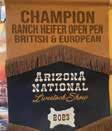
Bar T Bar low birthweight Balancer bulls have been part of our cow-calf operation for the past 10 years. Historically we retain 10 to 15 head of replacement heifers each year. The low birthweight bulls allow these first-calf heifers great success when calving. Over the years we have only lost one calf and assisted three or four heifers during calving.
Our Balancer heifers grow well on native pastures with only Crystalyx protein, tubs and balanced minerals. On average the heifers wean at 600 pounds and weigh 900 to 1,000 pounds when they calve each February.”
Timothy Jackson, Oak Tree Land and Cattle Company LLC, Sonoita, Arizona
Foreman Award Recipient
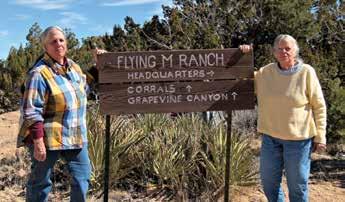

“We have been using Bar T Bar bulls for close to 30 years. Their genetics have made our cow herd almost drought proof. The cows have shelled out the milk, raised a good calf and rebred under some pretty harsh conditions. We have been at 90 percent or more breed up through some tough years. We think the feed efficiency of these cattle really pays off. Weaning good-sized, healthy calves on so-so feed and water is fantastic. Our replacements calve out mostly unassisted using BTB calving ease bulls. The calves are small at birth but catch up by fall and sell right along with our older cows’ calves. Not only do these genetics produce the maternal traits for us as a cow-calf operation, but our repeat calf buyers like how they grow and feed out. Thanks to Bob and Judy – and everyone at Bar T Bar – for sharing their knowledge and helping Flying M purchase bulls that fit our operation.”
“I’ve been buying and using Bar T Bar bulls since 2005. I chose Balancer bulls because they are hardy and they produce females that are fertile and make great mothers. Last fall my cows bred back 95 percent in short feed conditions and weaned calves averaging 665 pounds for steers and 628 pounds for heifers. The data that Bar T Bar provides on their bulls is very helpful in selecting the bulls that fit my criteria. My hats off to your 100th year ranch anniversary – congratulations!
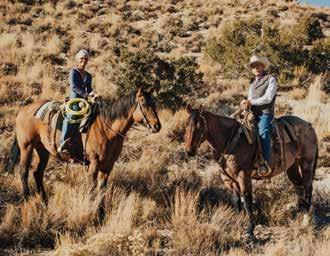

It’s been almost 20 years since we purchased our first Bar T Bar bull, and we haven’t looked back. We have been extremely satisfied with the results. Our pregnancy rates have increased in spite of the rough terrain we deal with. I believe that not only the rigor of the bulls but also the maternal traits they have shared with our herd has made the difference. Many years ago I took a tour of the Bar T Bar Ranch and, at the time, I wished my herd looked like Bob and Judy’s. It’s beginning to happen. The quality of the bulls and the positive effect they have had is great, but the main reason we keep coming back is because of the way Bob and Judy treat their customers. Thank you, guys.
Homestead Award Recipient

eeeee Easiest calving bulls in the industry.
eeee For use on smaller heifers with Minimal assistance.
eee For use on larger heifers with some assistance.

Are you concerned about Feet, Disposition or
eeeee These bulls excel in the trait and are trait improvers.
eeee These bulls are at the top of the class and very solid for the trait.
eee You will not go backward on the trait. Use to maintain the trait in question.
eeeee These will make the most Profitable, bullet proof heifer replacements in the industry.
eeee For use in herds that need to improve maternal traits.
eee For use in above average maternal herds to maintain maternal strength.
eeeee These will produce industry leading genetics in the Feedlot. Highly sought after feeder calves.
eeee For herds that want to improve Feedlot performance in their herds.
eee Used to maintain Feedlot performance and premiums in your herd.

CALVING EASE: The predicted calving ease if you use the bull on heifers.
The easiest calving bulls in the industry.
Use on smaller heifers with minimal assistance needed.
Use on larger heifers with some assistance expected.
(If no stars are shown, the animal is recommended for use on cows only.)
GROWTH: A formula combines WW and YW to predict how much performance the sire will pass on to their progeny.
Most growth.
MATERNAL: An estimate of the maternal efficiency of the daughters this sire will produce. It includes cow size, milk, udder quality, fertility/longevity, growth, feed efficiency/ intake and calving ease.
Keep these heifers! They will make the most profitable females in the business.
FEEDLOT: A formula that combines: gain, conversion, carcass weight and carcass merit to predict post weaning performance.
Maximum overall value in your feeder calves.
UDDER: An estimate of the daughter’s udder quality.
Thumb size teats and tight bag suspension.
FERTILITY: An estimate of the amount of calves the daughters will have in their lifetime.
Will produce about 2 more calves in their life time than 1-Star fertility.
DISPOSITION: An observation of the sires disposition.
Average - respects flight zones and handles well, but is not a pet.


$RANCH: Profit from birth through weaning. Includes:
• Fertility, Milk, Growth
• Cow feed intake and mature size
$FEEDER: Profit from weaning to harvest. Includes:
• Feed conversion
• Carcass value
• Carcass weight
$PROFIT: Puts it all together. $Ranch + $Feeder
• One number that predicts your bottom line!
FEED:GAIN: Difference in the amount of feed a bull's progeny will consume to produce one pound of gain.
Example: A -0.50 F:G EPD means this animal's progeny will consume 1/2 pound less feed per pound of gain than would progeny of a 0.00 F:G EPD sire.
FEED INTAKE: Difference in feed consumption of each of a bull's progeny in a 112 day feeding period.
Example: A steer whose sire has a -100 Intake EPD will eat 100 pounds less feed in 112 days than one whose sire had a zero Intake EPD.
You cannot afford to make mistakes in your breeding program! Choosing to use sires with incomplete or low value data can unknowingly make your herd less profitable - same work, same cost, poor results - unacceptable. $Profit® ABC’s are the most reliable and comprehensive EPD’s in the industry. They are backed by a large (nearly a million), long-standing (over 30 years), multi-breed (over 15 breeds) database. Using this system assures you of making sound breeding decisions with minimal risk of failure.
When it comes to picking bulls, the first thing you need to do is choose how to balance the traits. Maternal vs Feed/Carc. $Ranch vs $Feeder. Moderate cow size & fertility vs growth and carcass weight. Bar T Bar provides MORE data than any other bull producer. We also provide BETTER data.
Most catalogs are pretty good at telling you which bulls are terminal -- just look at indexes like $Feeder, $Beef, or TI, or TSI. However, there are almost no good indexes for finding ideal maternal bulls. At Bar T Bar, we have had the $Ranch index for some time. Now, we also have Udder stars and Fertility stars.
A few years ago we introduced a new concept: AllAround Bulls™. These bulls score four stars or more on BOTH Maternal and Feed/Carc. They are elite for both $Ranch and $Feeder. By definition, they are high on $Profit. The Bar T Bar sale offers more 4-Star and higher AllAround Bulls than any other sale in the country. Why or how? Simply put, we select for these bulls.
The AllAround Specialists are scored 4, 4.5, and 5 Stars. 5-Star AllAround bulls are five for both Maternal and Feed/Carc. 4.5-Star AllARound bulls are 4 on Maternal or Feed/Carc and 5 on the other. 4-Star AllAround bulls are 4 stars on both Maternal and Feed/Carc. We think that these AllAround bulls are the most valuable bulls in the industry. They give you maximum flexibility to keep heifers, sell calves, and/or feed our your calves and sell on a grid. These bulls will bring a little more, but they are worth it.
First choose your trait emphasis. Then buy as much $Profit as you can afford.

What you get:
Moderate, fertile, longlived cows
More pounds per acre
Many may excel in Feed/ Carc traits as well
High gaining and heavy carcass weight Better conversion and more grid value
Many may excel in Maternal traits as well
These bulls combine 4 & 5 stars on both Maternal & Feed/Carc
NOTE: AllAround bulls can also be used as either Maternal or Feed/Carc Specialists. They are just as good as the specialist. Be sure to include them on your lists.
This 5-Star Accuracy, 5-Star Maternal, Senior AI Herd Sire exemplifies the tremendous opportunity within our system to build an elite commercial herd that will stand the test of time. $Ranch 171 (Top <.1%), F:G .01 (Top 33%), Intake -2.5 (Top 18%), Mat. Wt. 2.9, Gest. -1.8, 4-Star Udder, 4-Star Disp., 5-Star Fertility. All with proven Balanced Proofs and a -3.1 BW. ABC/EPD.
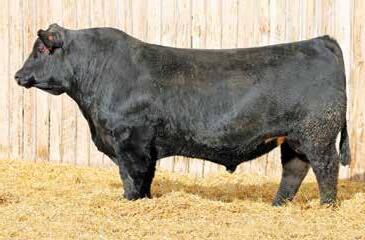

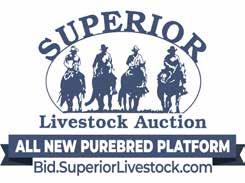

The auction will be broadcast online at Bid.SuperiorLivestock.com and the prerecorded videos will also be hosted there. You do not need an account just to watch the auction or view videos of the sale offering.
Go to Bid.SuperiorLivestock.com for Superior’s new online bidding platform. If you have not registered there before you will need to create an account if you wish to bid (there is no registration required just to watch the auction). Once you have created an account, request a buyer number and you will then be able to bid online with the largest and most trusted cattle marketing entity in North America. Superior’s new platform allows you to see both the live stream of the auction AND the pre-recorded videos on one screen at the same time!
This is Superior’s suggested bidding method for anybody who does not have consistent, high-speed internet. You still must register an account at Bid.SuperiorLivestock.com and request a buyer number and upon doing so you will see the bid line phone number. Just watch the auction online and call in at least 2 lots ahead of the lot you are looking to bid on.
FOR HELP WITH REGISTRATION OR ANY PART OF THE BIDDING PROCESS PLEASE CALL SUPERIOR
Bar T Bar is offering a one year guarantee on all bulls that we sell. This guarantee will cover your purchased bull(s) against death, injury, infertility, and loss of use. If, during the first year from purchase, you lose the use of your bull for whatever reason, we will give you a credit towards the purchase of a new bull. We only ask that your herd veterinarian provide a written statement describing the death, injury, or infertility. If the bull in question can be salvaged, we would like you to keep the salvage value, and a credit will be issued, less the salvage amount you receive for the bull. If the bull is turned out for breeding, then the credit will be given at 75% of the original purchase value (less any salvage value). All claims must be made within 1 year from the date of purchase and cannot exceed the greater of 2 bulls per invoice or 15% of the total invoice.
Example 1: Your $5,000 bull dies before you turn him out to breed. You receive a full credit of $5,000. (Purchase Price - $0 Salvage - $0 Use).
Example 2: Your $5,000 bull injures his scrotum after you pull him from the cows. You sell him for $1000 in salvage. You receive a credit of $2,750 ($5000 purchase - $1000 salvage - $1250 usage).
Requirements for claims:
1. All claims must be made within 365 days of purchase.
2. A veterinary statement regarding the circumstances is required.
3. A verbal agreement from Bar T Bar Ranch is required prior to a bull being sold for salvage. Documentation of the salvage value of the bull, including identification of the bull on the sale barn ticket, that corresponds to the bulls Bar T Bar identifications (ear tag or metal clip) is also required.
This credit can be used for the purchase of bulls, females, semen, and/or embryos from Bar T Bar. If the credit is not used within 24 months of the date of issuance, then it will expire.
Note: Guarantee will be revoked on all bulls that are not paid for within 30 days of invoice date.
Terms and Conditions: The cattle will sell under the Terms and Conditions of the American Gelbvieh Association and the American Angus Association. In the event of default in any part of the Terms and Conditions covering the sale by either the buyer or seller, it shall be the responsibility of the buyer or seller to instigate any action necessary to bring about a fair settlement of any claims arising from the sale and to be responsible for any costs included therein. The sale management assumes no responsibility, legal or otherwise, for the failure of either buyer or seller to fulfill their obligations.
Disclaimer: Although all has been done to make sure this is a safe sale to attend, please do so at your own risk. The owners of Bar T Bar Ranch or any of the Leachman Cattle employees and the sale management take no responsibility for any accident or loss that you may incur.

1. Reg#: the registration number of the animal. NotReg means the animal is not registered. Pending means that a registration number has been applied for, but was not issued at the time of catalog printing.
2. Brd: Shows the percentage of each breed.
3. DOB: date of birth
4. P = polled. S = scurred. H = horned. PP = Homozygous Polled. PH = Heterozygous Polled.
5. Cooperator herd where the bull was raised.
6. Color: BBK=homozygous black, BLK = black, BWF = black white face, BBF = black brockle face, RED = red, RWF = red white face, WHT = white, BRC = black red carrier.
7. Pen numbers will be on Supplement sheet.
8. Genetic Defect codes - a C appended to the end denotes carrier and an F denotes tested free and P denotes possible but untested.
NH - Neuropathic Hydrocephalus
AM - Arthrogryposis Multiplex
CA - Contractural Arachnodactyly
OS - Osteopetrosis
DD -Developmental Duplication
Phenotype Scores to Make Bull Buying Easier:
9. CE: Calving Ease is the predicted calving ease if you use the bull on heifers. If there is a number in the brown box, this indicates the breed calculated calving ease direct EPD. In addition, we provide our Leachman estimated calving star system.
***** The easiest calving bulls in the industry.
**** Use on smaller heifers with minimal assistance needed
*** Use on larger heifers with some assistance expected.
10. Maternal: This is an estimate of maternal efficiency, NOT milk. It includes $Ranch, Udder EPD and Fertility EPD as the basis for the Star system. The bulls are scored from one star to five stars. Five Star bulls will produce some of the most profitable, good uddered cows in the industry.

11. Fertility: Predicts the number of calves that a bull’s daughters will have in the first 8 years of their life. As Fertility stars go up we would expect you to have a higher % weaned calf crop.
12. Udder EPD: This EPD assesses the bag attachment and teat size of the bull’s daughters. Bulls with 5 & 4 stars should sire females with exceptional udder quality.
13. Growth: This is a score from one star to five stars, where five stars means maximum growth. Even the one star bulls are as growthy as any bull in America 20 years ago.
14. Feedlot: This looks at all of the post weaning traits including gain, conversion, carcass weight, and carcass merit. Scored from one star to five stars, where five stars would produce maximum overall value in your feeder calves.
15. Feet: Is an estimate of the claw shape of an animal’s feet. The bulls are scored on a 1 to 5 scale. Bulls that are 5 and 4 Star for Feet should improve your herds feet and have a low incidence of claw issues himself. One star bulls should be used in a terminal breeding program.
16. Disposition: Our traditional score of 1 – 5 on disposition. Score 5 bulls are bulls you can walk up to and touch. Score 3 is about average historically for Leachman bulls. However, we are making a concerted effort to improve disposition, so most bulls score 3 or higher. The bulls scored 2.5 or 2 are nervous and do not like to be in close quarters with people on foot – but they are great for big range operations.
17. Phenotype: A combination of eye appeal and overall kind. Scored from one star to five stars. Five star bulls are the best phenotypic bulls in the sale (in our opinion)! Two star bulls are less attractive visually than average.


18. $Ranch EPD: This Leachman profit index that predicts weaning profitability based on calving ease, weaning weight, maternal milk, cow cost, and FERTILITY. Based on producing 100 calves. This EPD assumes a slide on calf prices of $10 / cwt.
19. $Feeder: This number is expressed in terms of the bull’s added value to the sale price of your feeder calves. It is expressed in dollars per head. Thus when comparing a +100 bull vs. a +50 bull, we expect the first bull to sire calves worth $50 per head more at weaning (regardless of their weight).
20. $Profit™ EPD: One, simple, proven number that gives each trait a weight according to its impact on profit.
Breed Association EPDs (Expected Progeny Differences) are listed for all registered animals. Leachman ABCs (Across Breed Comparisons) are listed for all un-registered animals. All ABCs are on an Angus base and can be compared across breeds within this catalog. EPDs are appropriate association EPDs without any adjustments.
21. Calving Ease Direct EPD from AGA on the Gelbvieh and from AAA on the Angus.
22. Calving Ease Maternal EPD from AGA on the Gelbvieh and from AAA on the Angus.
23. Birth weight EPD from AGA on the Gelbvieh and from AAA on the Angus.
24. Weaning weight EPD/ABC expressed on a breed scale. The Composites are expressed on an Angus scale.
25. Yearling EPD/ABC expressed on a breed scale. The Composites are expressed on an Angus scale.
26. Milk EPD/ABC expressed on a breed scale. The Composites are expressed on an Angus scale. This is the best predictor of a bull’s daughter’s ability to milk. It measures the difference in weaning weight that will be produced between one bull’s daughters and another bull’s daughters due solely to milk.
27. MWT is the predicted mature weight of daughters that you will get if you use the bull on a 1250 pound cow. If your cows weigh 1350, add 100 to this predicted weight. If your cows weigh only 1150, subtract 100 from this predicted weight. This EPD is the best indicator of daughter size -- far better than frame score or yearling height.
28. YHT is an EPD, expressed as frame score, predicting the yearling frame score of a sire’s progeny, compared to that of other sires.
29. IMF is the ultrasound based EPD/ABC for marbling expressed on a breed scale. The Composites are expressed on an Angus scale.
30. REA is the ultrasound based EPD/ABC for ribeye area expressed on a breed scale. The Composites are expressed on an Angus scale.
31. F:G is the pedigree estimated feed to gain EPD that predicts the feedlot efficiency of the bulls offspring. A negative number means that the bull’s progeny will feed more efficiently. Example: -0.50 means that the bulls progeny will require ½ pound less feed per pound of gain.
32. Intake: is an estimate of the amount of feed that the bull’s progeny will consume over a 112 day feeding period. It is expressed in pounds. Animals with higher intake will consume more throughout their life. Animals with lower intake will consume less.
33. SC is an EPD, expressed in centimeters, predicting the yearling scrotal circumference of a sire’s progeny, compared to that of other sires.
34. PAP: PAP EPD. Actual PAP Scores will be on supplement sheet .
35. Bulls with the red “Southern Balancer” have > 12% American Breeds.
Key to bull comments:
• Any reference to % rank is the percentile rank within that bull’s breed. Top 1% means the animal ranks better than 99% of the population on that trait.
• Reference to the number rank (i.e. #2 $Profit) is the bulls rank within his breed within the sale bulls for that trait. So, #4 F:G ST means the 4th best Feed:Gain Stabilizer bull in the sale.
• Other abbreviations used in the comments include:
• Dam 5@101 NR – indicates that the bull’s dam has five calves with an average weaning ratio of 101
• WR & NR = weaning or nursing ratio. How the calf ranked within herd on their adjusted weaning weight.
• YR = yearling ratio. How the calf ranked within herd on adjusted yearling weight.
• AWW = adjusted 205 day weaning weight. AYW = adjusted 365 day yearling weight.
• REA & IMF = either adjusted data or ratios for ultrasound ribeye area and inter-muscular fat (marbling).
• ADG = average daily gain on test. WDA = weight per day of age at a year.

Revenue Creator.
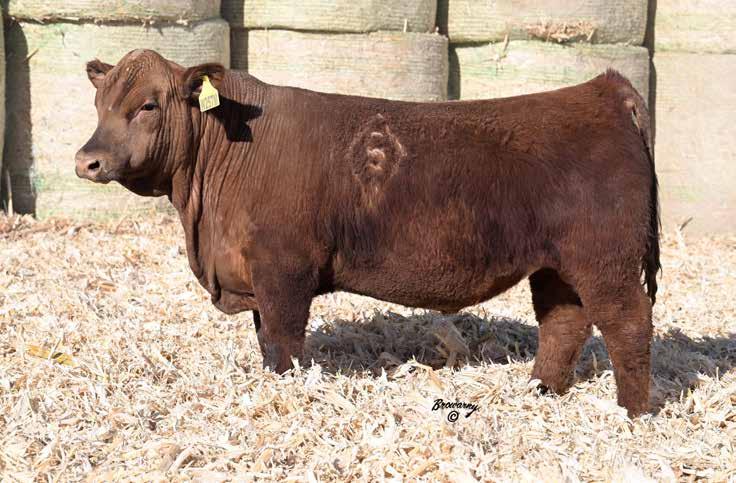

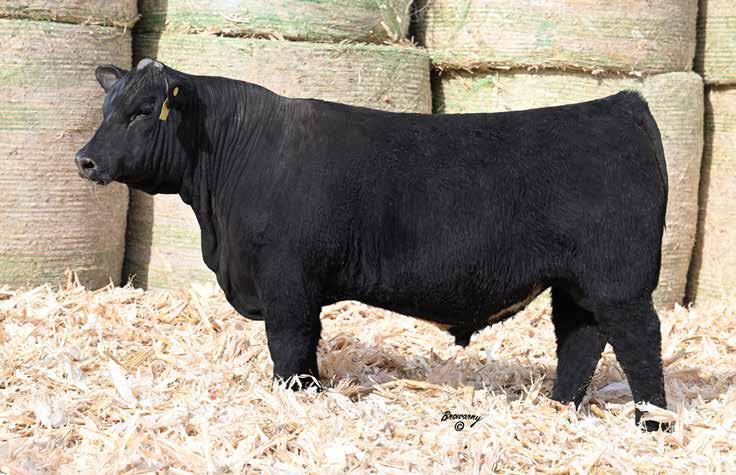

#2 $Profit, #28 $Ranch, #4 $Feeder, #29 Marb, #5 Ribeye, #6 Udder 4.75 Star All-Around Specialist! G4015 GDDG 4015M


C. Ease Maternal Cow Fert Udder Growth
eee eeeea eeeea eeeee eeeea eeeea eeeee eeeca eeeec
$Ranch $134 4% $Feeder $221
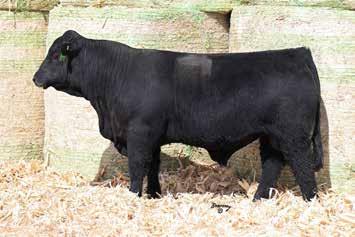
$Ranch $135 4% $Feeder
#13 Ribeye EPD, Top 10.7% Carcass Wt EPD 3 Star Maternal and Calf Revenue Creator.

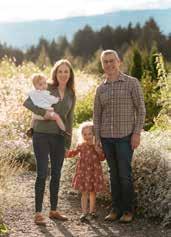


C. Ease Maternal Cow Fert Udder Growth Feed/Carc Feet
eeeea eeeea eeeee eeeea eeeee eeeec eeeec eeeee
$Profit,
C. Ease Maternal Cow Fert Udder Growth Feed/Carc Feet Dispo
eeee eeeea eeeea eeeea eeeaa eeaaa eeeea eeeaa
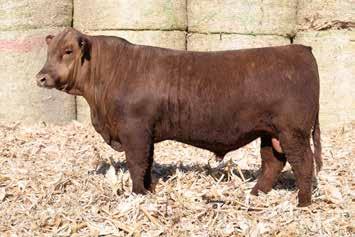
$Profit, #5 $Feeder, #8 Marbling EPD, #23 Ribeye EPD 4.5 Star All-Around Specialist!
C. Ease Maternal Cow Fert
eeeee eeeaa eeeaa eeeea eeeaa eeaaa

#26 Ribeye EPD, Feet
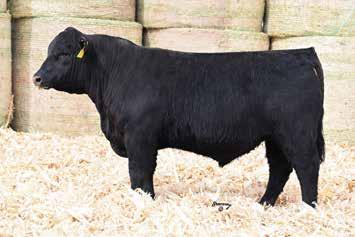

C. Ease Maternal Cow Fert Udder Growth
eeeee eeeea eeeea eeeee eeeaa eeeee eeeea eeeca eeeec $Ranch
#19 $Profit, #11 $Feeder, #20 PAP EPD, #4 Marb EPD, #27 Udder EPD 4.5 Star All-Around Specialist!
C. Ease Maternal Cow Fert Udder Growth Feed/Carc Feet Dispo Pheno eeeea eeeea eeeea eeeea

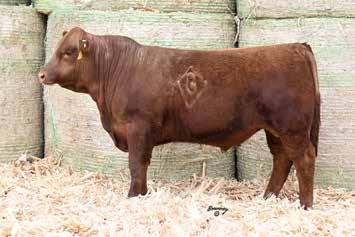
C. Ease Maternal Cow Fert Udder Growth Feed/Carc Feet Dispo
eeee eeeee eeeee eeeee eeeaa eeeea eeeea eeeea eeeec $Ranch $163 1% $Feeder $220
#9 $Profit, #8 $Ranch, #21 $Feeder, #7 Cow Fert, #29 Marb, #30 F:G 4.5 Star All-Around Specialist! 4030
Lot G4029 Lot 4029
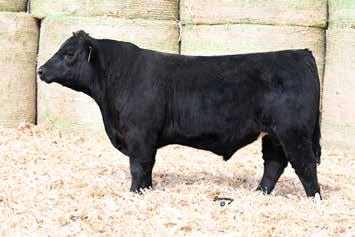


C. Ease Maternal Cow Fert Udder
eeeee eeeaa eeaaa eeeee eeeaa eeeaa eeeea eeeca eeeec $Ranch
#25 PAP EPD, Top 5% Marbling, Top 6.4% Ribeye 3 Star Maternal and Calf Revenue Creator.
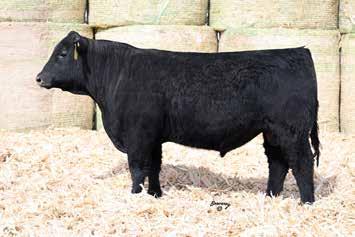
C. Ease Maternal Cow Fert
eeeee eeeaa eeeaa eeeca eeaaa eeaaa
A Brangus influenced bull with solid numbers across the board.
#21 $Profit, #8 $Feeder, #30 PAP EPD, #3 Marbling EPD 4.5 Star All-Around Specialist!
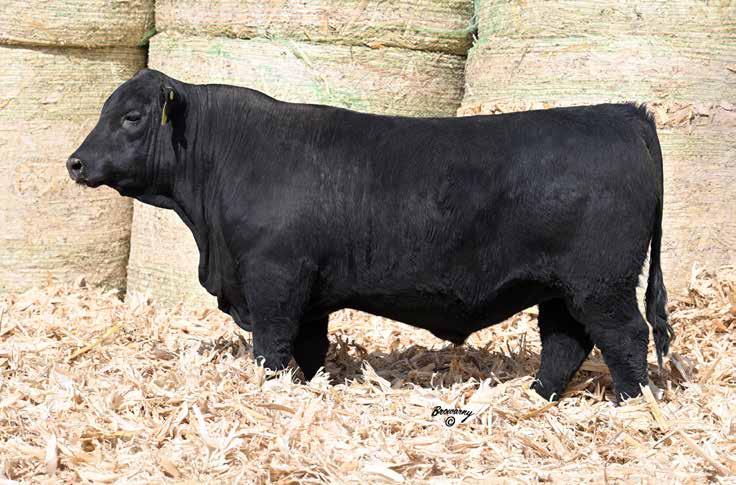

C. Ease Maternal Cow Fert Udder
eee eeeaa eeeaa eeeee eeeea eeaaa eeeca
Vercingetorix
Kickoff S479K
C. Ease Maternal Cow Fert Udder
eeee eeeaa eeeaa eeeca eeeea eeeea eeeca eecaa eeeaa
$Ranch $66 28% $Feeder $224 0.3% $Profit
3% #17 $Feeder, #22 PAP EPD, #24 YWT EPD, #21 Marb EPD, #22 F:G 4-Star Calf Revenue Creator -- Average or better Maternal.
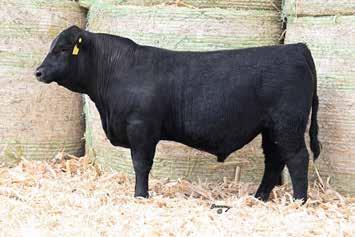
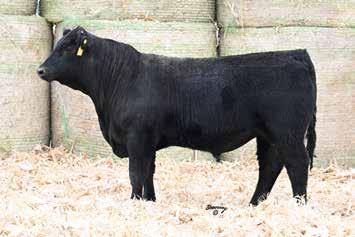


eeeea
eee eeeea eeeea eeeca eeeaa
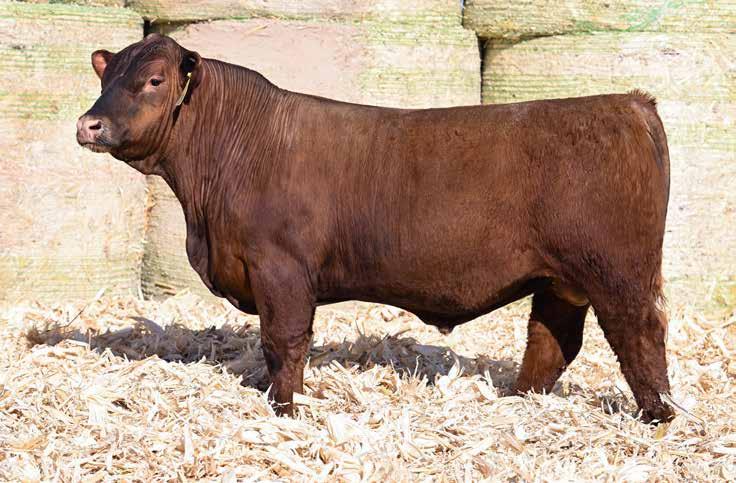

C. Ease Maternal Cow Fert Udder Growth
eeeee eeeaa eeeaa eeeca eeeaa eeeaa eeeec eeeea eeeec
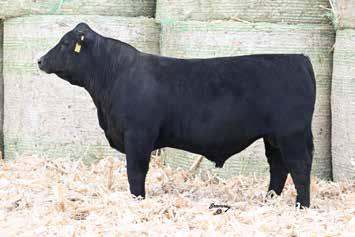
C. Ease Maternal Cow Fert Udder
eeee eeeec eeeea eeeee eeaaa eeaaa eeeec eeeea eeeea
Maternal
eeeaa eeeea eeeaa eeeee eeeaa eeeec eeeca eeeee
$Ranch $92 15% $Feeder $186 2% $Profit $22,483 3%

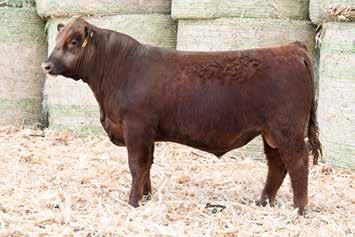


C. Ease Maternal Cow Fert Udder
eee eeeea eeeea eeeca eeeee eeeaa eeeea
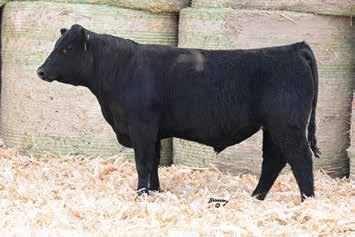
C. Ease Maternal Cow Fert Udder
eeeea eeeea eeeca eeaaa eaaaa eeeec eeeec eeeaa $Ranch $109 9% $Feeder $28
C. Ease Maternal Cow Fert Udder Growth Feed/Carc Feet Dispo Pheno eeeee eeeea eeeea eeeee eeaaa eeeaa eeeaa eeeca eeeca
$Ranch $99 13% $Feeder $153 5% $Profit $20,879 5% #23 Udder EPD, Top 9.4% Cow Fertility, Top 2.1% Marbling 4 Star Maternal -- Build a Better Cowherd.
4103
Jaxon M398J

C. Ease Maternal Cow Fert Udder Growth Feed/Carc Feet
eeeea eeeea eeeca eeeaa eeeea eeeaa eeeca eeeaa
#19 PAP EPD, #25 Marbling EPD, Top 4.5% Cow Fertility 4 Star All-Around Specialist!
C. Ease Maternal Cow Fert
eeeee eeeea eeeaa eeeee eeeaa eeeaa
#28 Ribeye EPD, Feet Improver! Top 5% Marbling 4 Star Maternal -- Build a Better Cowherd.
#3 $Feeder,
C. Ease Maternal Cow Fert Udder Growth Feed/Carc Feet Dispo
eeeee eeeaa eeeaa eeeee eeaaa eeaaa eeeaa eeeca eeeca
$Ranch $95 14% $Feeder

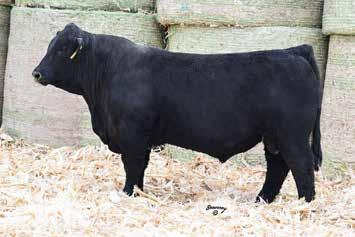

Jaxon M398J

C. Ease Maternal Cow Fert Udder Growth Feed/Carc Feet Dispo Pheno eeee eeeea eeeea eeeca eeeaa eeeaa eeeea eeeca eeeea
C. Ease Maternal Cow Fert
eee eeeea eeeea eeeea eeeaa eeaaa eeeca eeeca
C. Ease Maternal Cow Fert Udder Growth
eeee eeeec eeeea eeeee eeaaa eeaaa eeeea eeeca eeeea $Ranch $162 1% $Feeder $71 40%
1601146
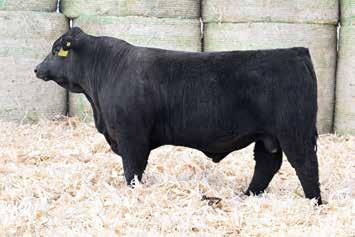

C. Ease Maternal Cow Fert Udder Growth Feed/Carc Feet Dispo
eeeaa eeeaa eeeee eeeea eeeea eeeca eeeaa eeeee
#22 Weaning WT EPD, #2 Marbling EPD, #14 Udder EPD 4-Star Calf Revenue Creator -- Average or better Maternal.
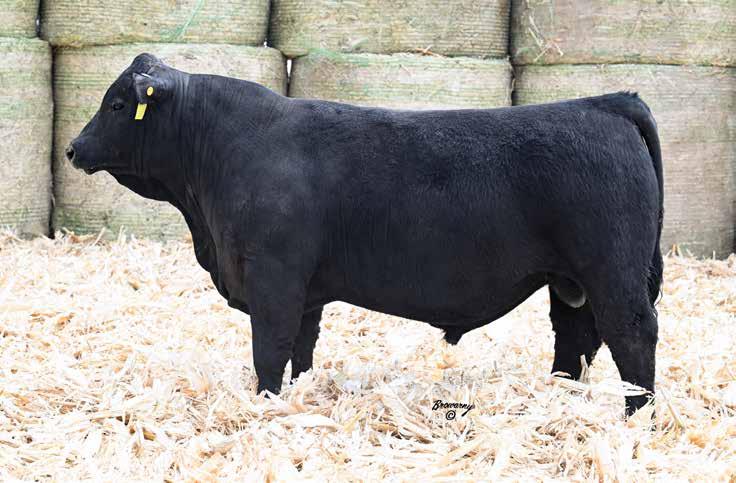


C. Ease Maternal Cow Fert Udder Growth Feed/Carc Feet
eeeee eeeea eeeea eeeca eeeaa eeaaa eeeea eeeca eeeca
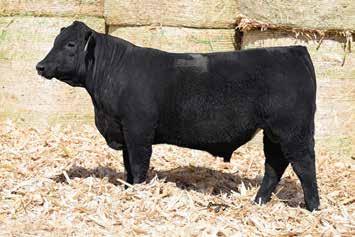
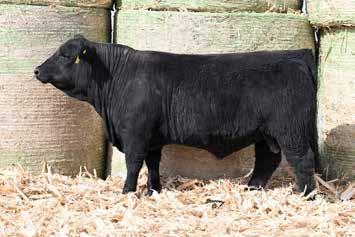
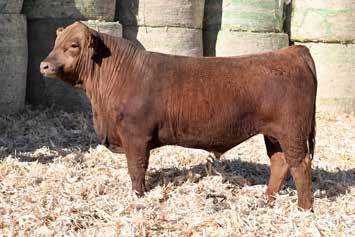

C. Ease Maternal Cow Fert Udder Growth
eeeee eeeaa eeeea eeeaa eeaaa eeaaa eeeec eeeca eeeea
#19 Marbling EPD, Top 10% Cow Fertility EPD 4-Star Cow Fertility!
C. Ease Maternal Cow Fert Udder
eeeee eeeea eeeea eeeee eeeaa eeaaa eecaa eeeea eeeec

Ease Maternal Cow Fert Udder Growth Feed/Carc Feet Dispo
eeeee eeeea eeeea eeeee eeeaa eeaaa eeeec eeeea eeeea
$Ranch $137 4% $Feeder $117 16% $Profit $22,126 3%


C. Ease Maternal Cow Fert Udder Growth Feed/Carc Feet
eeeee eeeea eeeea eeeee eeaaa eeaaa eeeea eeeea eeeaa
#9 PAP EPD, #4 Udder EPD, Top 9.4% Cow Fertility, 4 Star Maternal -- Build a Better Cowherd.
C. Ease Maternal Cow Fert Udder
eeee eeeea eeeea eeeea eeeaa eeaaa
#20 $Ranch, #26 PAP EPD, #16 Marbling EPD, Top 5% Cow Fertility, 4
C. Ease Maternal Cow Fert Udder Growth
eeeee eeeee eeeee eeeaa eeaaa eeeea eeeca eeeec $Ranch $152 2%
#23 $Ranch, #23 Cow Fertility EPD, #1 Feed:Gain EPD, #17 Udder EPD, 5 Star Maternal -- Build Better Cows!
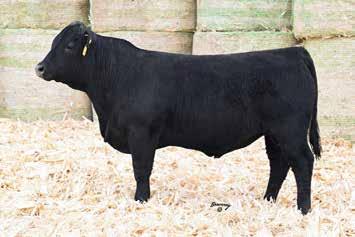
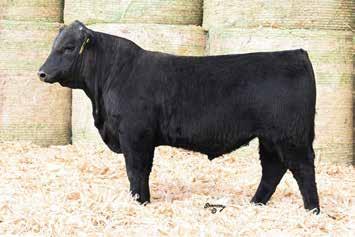
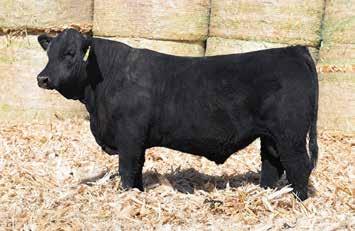
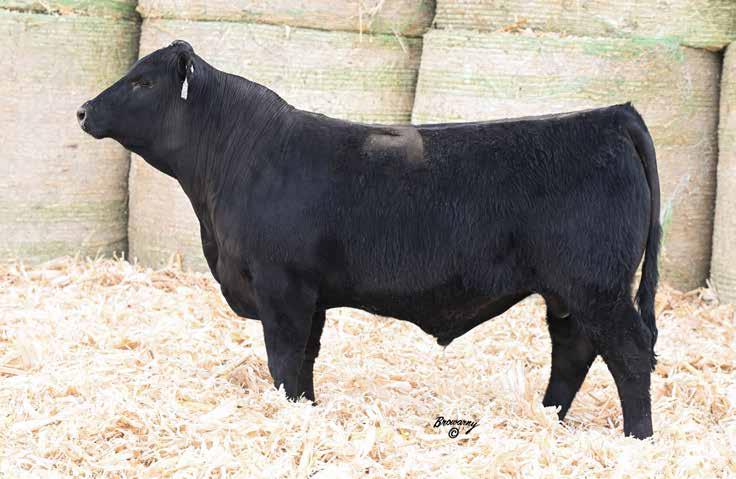

Ease Maternal Cow Fert Udder
eeee eeeaa eeeaa eeeca eeeaa eeaaa eeeec eeeaa eeeea
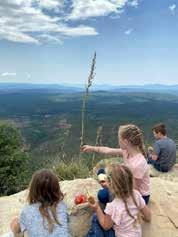


C. Ease Maternal Cow Fert Udder Growth Feed/Carc Feet Dispo Pheno eeeea eeeea eeeee eeeee eeaaa eeeec eeeca eeeec $Ranch $137 4% $Feeder $142
#11 WWT EPD, #14 YWT EPD, #10 Ribeye, #12 F:G, #17 Carcass Wt EPD 4 Star Maternal -- Build a Better Cowherd.
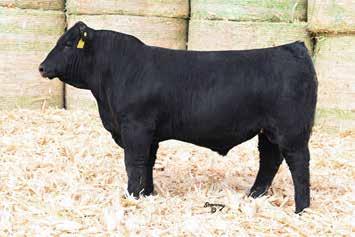
C. Ease Maternal Cow Fert Udder Growth
eeeaa eeeaa eeeee eeeee eeeaa eeeea
Dispo
C. Ease Maternal Cow Fert Udder Growth
eeee eeeea eeeea eeeca eeeaa eeaaa eeeec eeeca eeeec
$Ranch
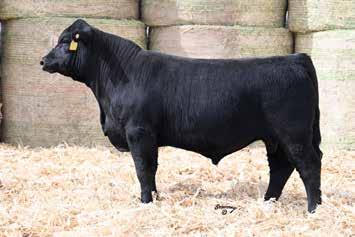
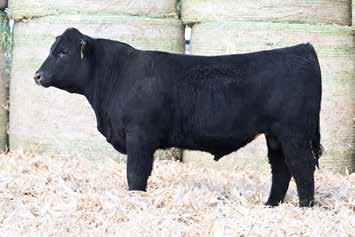
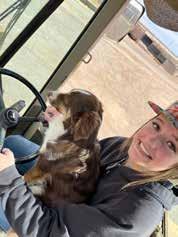

C. Ease Maternal Cow Fert Udder Growth
Feet Dispo
eeeea eeeea eeeee eeeaa eeeea eeeec eeeca eeeee $Ranch $129
#27 $Feeder, #28 Marbling EPD, #18 Udder EPD, #19 Carcass Wt EPD, 4 Star All-Around Specialist!
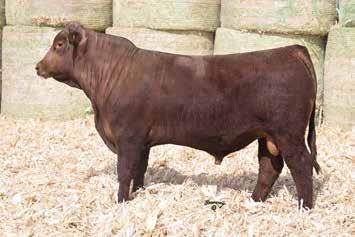



C. Ease Maternal Cow Fert Udder Growth Feed/Carc Feet Dispo Pheno eeeaa eeeaa eeeee eeeaa eeaaa eeeec eeeaa eeeec
C. Ease Maternal Cow Fert Udder Growth
eecaa eeeaa eeeca eeeee eeeee eeeec eeeca eeeea $Ranch $37 46% $Feeder $241
BottomLine K033J
C. Ease Maternal Cow Fert Udder Growth Feed/Carc Feet Dispo Pheno eee eeeec eeeee eeeca eeeea eeeaa eeeaa eeeea eeeca
$Ranch $142 3% $Feeder $194 1% $Profit
#30 $Profit, #9 Cow Fertility EPD, #18 Ribeye EPD 4.5
4247
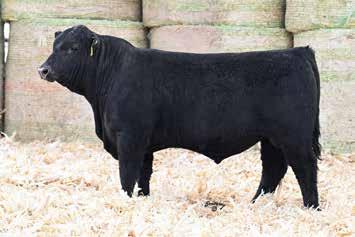

eeeaa eeeaa eeeca eeeea eeaaa eeeea eeeec eeeee $Ranch $107 10% $Feeder $145 7% $Profit
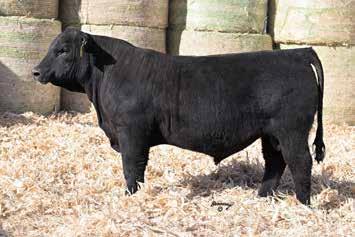



C. Ease Maternal Cow Fert Udder
eeee eeeec eeeea eeeee eeeaa eeeaa eeeca eeeaa eeeec
C. Ease Maternal Cow Fert
eeeea eeeea eeeca eeeaa eeaaa eeeca
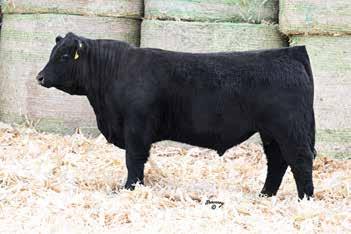
Doc Diablo 6306
Black Cross 0209 ET
Ease Maternal Cow Fert Udder Growth Feed/Carc Feet Dispo Pheno eee eeeaa eeeaa eeeca eeeea eeeaa eeeaa eeeca eeeea
$Ranch $85 18% $Feeder $152 6% $Profit $19,436
4267 MR BLACK CROSS 4267M
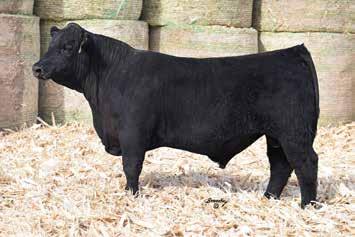

C. Ease Maternal Cow Fert Udder Growth
eeee eeeea eeeea eeeca eeeea eeeaa eeeaa eeeca eeeec
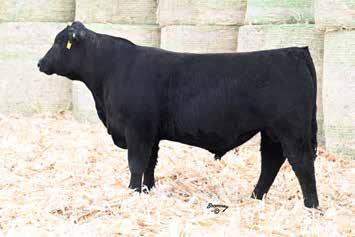
Lot 4268
C. Ease Maternal Cow Fert
eee eeeea eeeea eeeee eeeaa eeaaa eeeea eeeea

4277
1603245
C. Ease Maternal Cow Fert Udder Growth Feed/Carc Feet
eeeea eeeea eeeea eeeaa eaaaa eeeea eeeec eeeec
$101 12%
12% Cow Fertility EPD,
C. Ease Maternal Cow Fert Udder Growth Feed/Carc Feet Dispo
eeee eeeaa eeaaa eeeea eeeea eeaaa eeeec eeeca eeeec
Lot 4270 Lot 4277
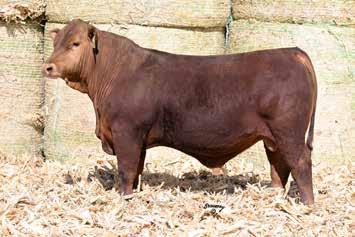
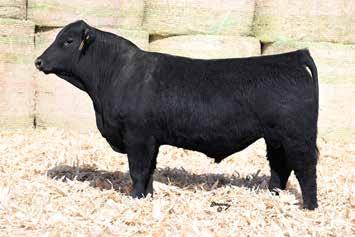


C. Ease Maternal Cow Fert Udder Growth
Feet
eeeea eeeea eeeea eeeaa eeeaa eeeee eeeca eeeea
#4 Ribeye EPD, #30 Feed:Gain EPD, Feet Improver!
4.2% Cow Fert 4 Star Maternal -- Build a Better Cowherd.
C. Ease Maternal Cow Fert Udder Growth Feed/Carc
eaaaa eeaaa eeeaa eeeea
C. Ease Maternal Cow Fert Udder Growth Feed/Carc Feet Dispo Pheno eeeea eeeee eeeea eeeee eeaaa eeeea eeeca eeeea
$Ranch $137 4% $Feeder $147 7% $Profit
5673 B
5154 W
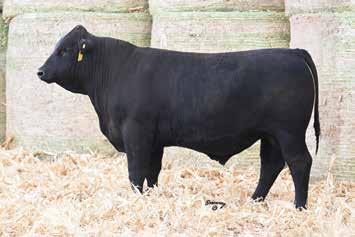

$Ranch, #11 Cow Fertility EPD, #3 Udder EPD, Feet Improver! 5 Star Maternal -- Build Better Cows!
C. Ease Maternal Cow Fert Udder Growth
eee eeeaa eeeaa eeeca eeeea eeeaa eeeea eeeea eeeea
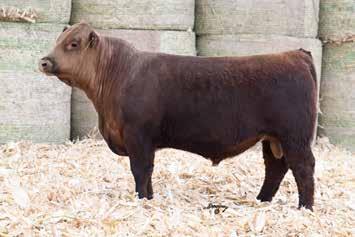
Ease Maternal Cow Fert
eeee eeeec eeeea eeeee eeeaa eeaaa eeeec eeeaa eeeea

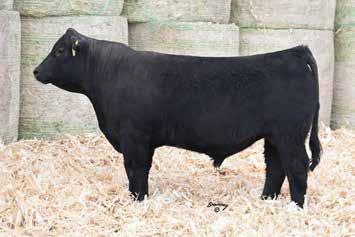

eeeea eeeea eeeaa eeaaa eeeaa eeeaa eeeaa
$Profit, #24 $Ranch, #18 REA, Top 9.7% Cow Fert, Top 1.9%
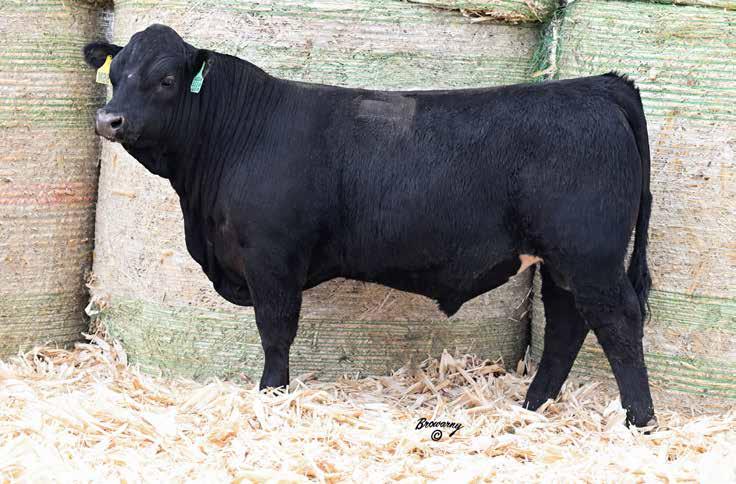

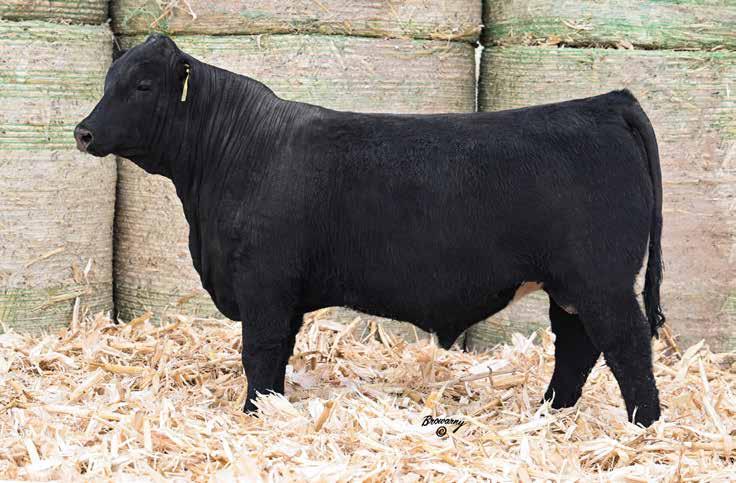


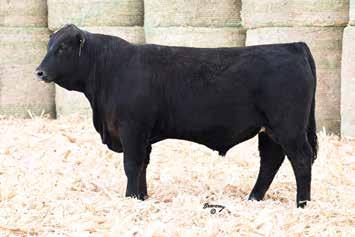

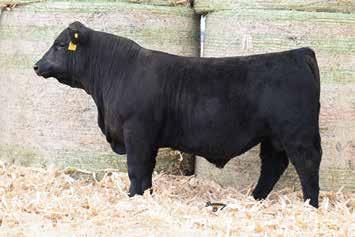

Lot 4357

Ease Maternal Cow Fert Udder
eeeea eeeea
C. Ease Maternal Cow Fert Udder Growth
eeeaa eeeaa eeeee eeeaa eeeaa eeeea eeeea eecaa $Ranch $51 36% $Feeder
4363


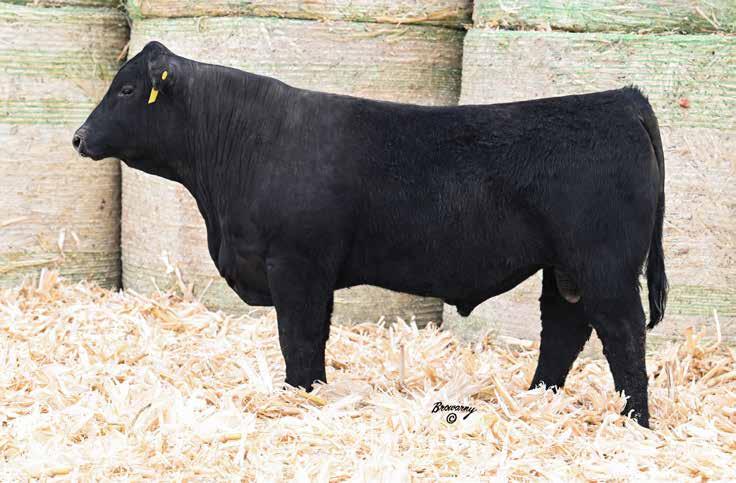
1601441 3/27/24

C. Ease Maternal Cow Fert Udder Growth Feed/Carc Feet Dispo Pheno eeeaa eeeaa eeeee eeeee eeeea eeeec eeeea eeeea $Ranch $56 33% $Feeder
#16
$Feeder, #14 WWT EPD, #21 YWT EPD, #18 F:G EPD, #14 CWt EPD 4-Star Calf Revenue Creator -- Average or better Maternal.
C. Ease Maternal Cow Fert Udder Growth Feed/Carc Feet Dispo
eee eeeea eeeee eeeaa eeeaa eeeaa eeeec eeeca eeeec
#17 $Profit, #22 $Ranch, #23 Cow Fert EPD, #8 Ribeye EPD, #15 C Wt 4 Star Maternal -- Build a Better Cowherd.
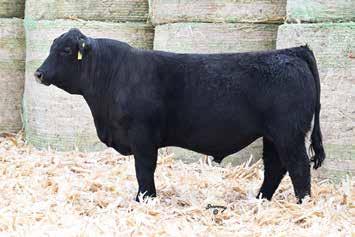
Lot 4380
C. Ease Maternal Cow Fert Udder Growth Feed/Carc Feet Dispo Pheno eeeee eeeec eeeee eeeca eeaaa eeeaa eeeec eeeee eeeea
$Ranch $213 0.1% $Feeder $175 2% $Profit $33,741 0.1% #3 $Profit,
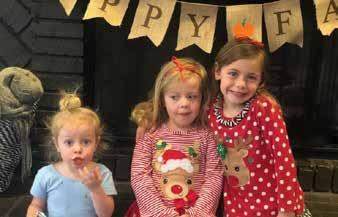


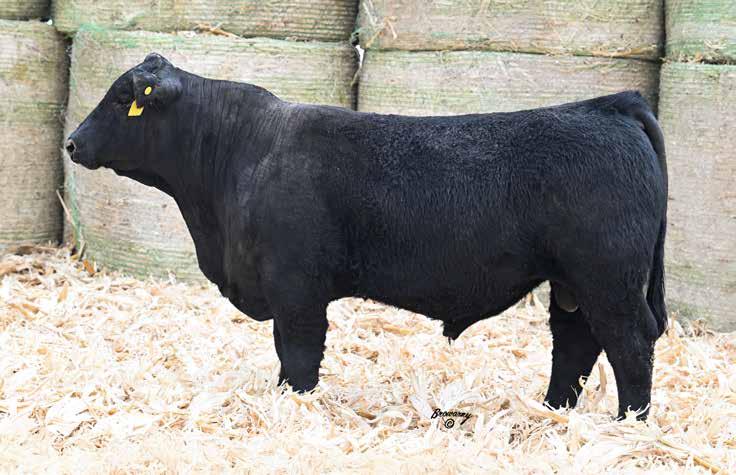

C. Ease Maternal Cow Fert Udder Growth Feed/Carc Feet Dispo
eeeaa eeaaa eeeee eeeee eeeaa eeeea eeeec eeeee $Ranch $26 52% $Feeder $193 1%





eecaa eeaaa eeeca eeeea eeaaa eeeea eeeea eeeea
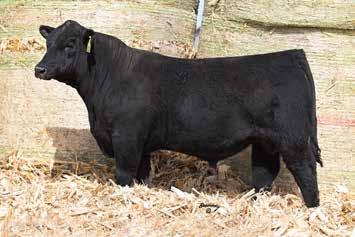


C. Ease Maternal Cow Fert Udder Growth Feed/Carc Feet
eeeaa eeeaa eeeaa eeeea eeaaa eeeec eecaa eeeee
#14 PAP EPD, #22 Weaning WT EPD, #28 Yearling WT EPD, #2 F:G EPD 4-Star Growth Bull!
431B
C. Ease Maternal Cow Fert Udder Growth
eeeee eeeea eeeea eeeca eeaaa
C. Ease Maternal Cow Fert Udder Growth
eeeaa eeeaa eeeee eeeee eeaaa eeaaa eeeca eeeee
$Ranch $51 37% $Feeder
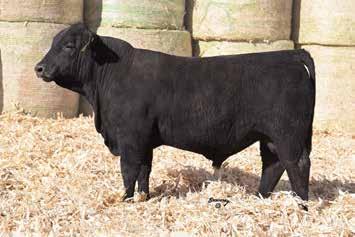




C. Ease Maternal Cow Fert Udder Growth Feed/Carc Feet Dispo
eecaa eeaaa eeeca eeeea eeaaa eeeea eeeca eeeec $Ranch $23 54% $Feeder $108 19% $Profit
#21 PAP EPD, #21 Yearling WT EPD, Top 11% Weaning Weight EPD 4-Star Growth Bull!
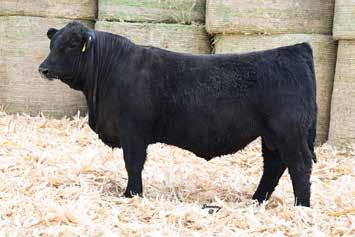
Bedrock M522F
Bedrock U200J

C. Ease Maternal Cow Fert Udder Growth Feed/Carc Feet Dispo Pheno eeeaa eeeaa eeeca eeeaa eaaaa eeeec eeeea eeeea
$Ranch $106 10% $Feeder $60 48% $Profit
A Southern Balancer with a 4.6% actual scanned IMF!
Decree X936D



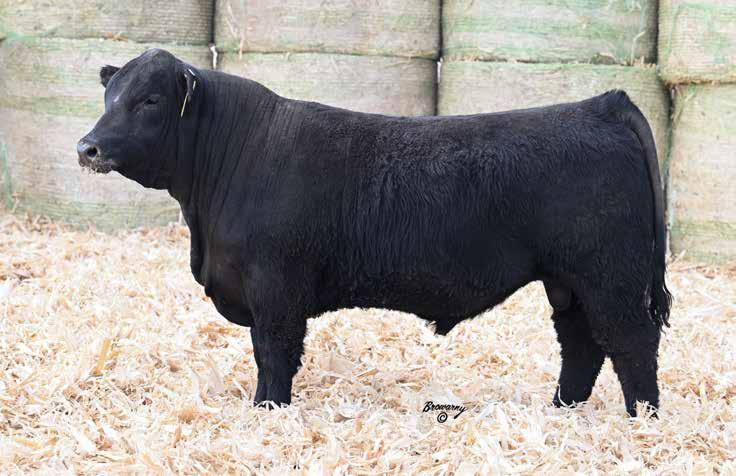

C. Ease Maternal Cow Fert Udder Growth Feed/Carc Feet Dispo
eeeee eeeea eeeea eeeea eeeaa eeaaa eeeec eeeea eeeec $Ranch $175 0.8% $Feeder $95
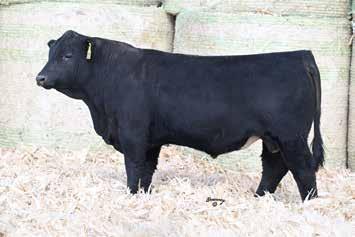

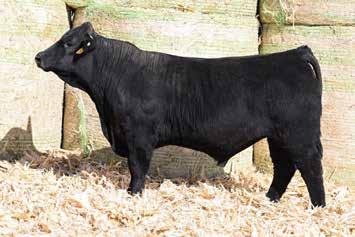



C. Ease Maternal Cow Fert Udder
eeee eecaa eeaaa eeeee eeeaa eeaaa eeeea eeeea eeeea
C. Ease Maternal Cow Fert Udder
eeeaa eeeaa eeeee eeeea eeeea eecaa eeeea eeeec
Bedrock M522F
C. Ease Maternal Cow Fert Udder Growth Feed/Carc Feet Dispo Pheno eeeea eeeaa eeeee eeeaa eeeaa eeeec eeeaa eeeaa
$Ranch $107 10% $Feeder $151 6% $Profit
#6 PAP EPD, #21 Ribeye EPD, with Strong Maternal traits. 4 Star Maternal -- Build a
Guiness S570J
Stabilizer FS846
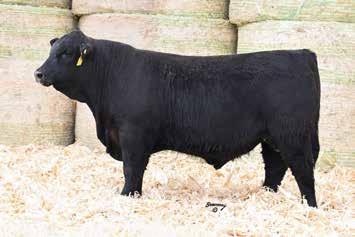
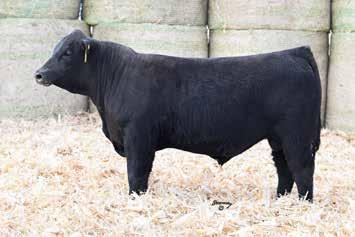


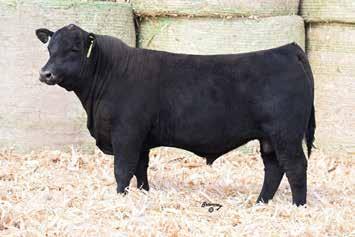

Decree X936D

C. Ease Maternal Cow Fert Udder Growth
eee eeeaa eeeea eeeaa eeeea eeaaa eeeec eeeaa eeeec
6.8% Cow Fertility, Top 11% Carcass Weight EPD 4-Star Growth Bull!
eee eecaa eeaaa eeeca eeeaa eeaaa eeeca eeeaa
Udder Growth
Dispo
eeee eeeea eeeea eeeee eeeaa eeaaa eeeaa eeeaa eeeec
$Ranch $109 9% $Feeder $147 6% $Profit $21,517 4% Top
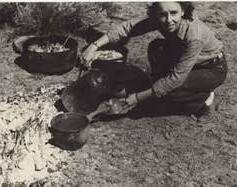
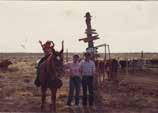
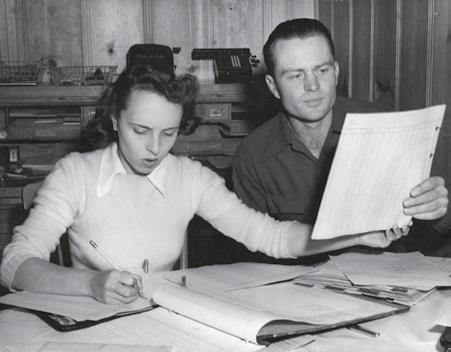

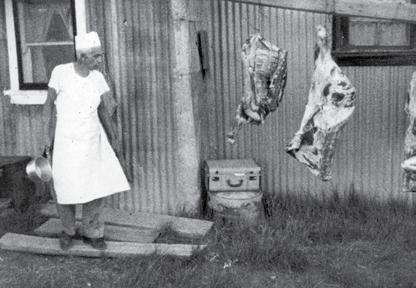

Quarter Circle H Angus LLC was established in 1985 as Quarter Circle H Farm and raised Holstein replacement heifers and alfalfa hay. A strong interest in animal genetics initiated the change from Holsteins to Angus cattle in 1996. After spending a little more than a year learning Angus genetics, expected progeny differences (EPDs) and traveling around the country looking at a lot of fine Angus cattle and talking to breeders, we purchased our foundation herd of 10 females from Mark and Abby Nelson of 5 Star Land and Livestock, Wilton, CA.
Since purchasing our foundation herd of registered Angus to produce our seedstock cattle, we have focused on breeding our females to balanced herd sires that provide genetics to improve calving ease, growth, carcass and efficiency. We have seen firsthand – through our enrollment in the American Angus Associations AHIR program and our association with the Bar T Bar ranch – the value of paying
Diamond G Ranch is a family-owned and operated ranch established in 1964. Located at the base of Mt. Taylor in Cibola County, managing the ranch during drought is a delicate balance between stocking density, feed and water availability, and matching the right type of cattle to our environment. Grazing management has long been the most important factor for successful and sustained range livestock production on our ranch. Like most New Mexico range livestock producers, Diamond G Ranch is in the business of forage production. Diamond G’s cow herd genetics are fundamental to our drought management plan, helping to ensure cow herd fertility remains high during sustained periods of drought.
Diamond G Ranch has used Bar T Bar Ranch Southern Balancer genetics for more than 20 years. Our cattle are registered hybrid seedstock that have documented pedigrees and expected progeny differences (EPDs). Diamond G Balancer cattle are 25 to 75 percent Gelbvieh with the balance of Angus or Red Angus. Balancer cattle combine Gelbvieh growth, fertility, longevity and low Yield Grade with Angus carcass qualities. The Diamond G Balancer cow herd has maintained a consistent, high (approximate 90
attention to EPD and DNA data, and data and selecting traits that improve cattle genetics not only for our herd but our customers’ herds as well. We have been involved with the Bar T Bar Bull Sale since its inception and feel very fortunate to be included in the 2025 sale.
Diane and Larry Holland of Quarter Circle H Angus with their grandchildren.

percent or better) breeding percentage, a 60-day breeding season and average weaning weights of 550 to 600 lbs.
A good drought management plan is all about taking the “guesswork” out of decision-making and helping producers take control of their production and marketing options. Balancer cattle are an integral part of our drought management plan and have allowed the Diamond G Ranch to make proactive decisions that minimize negative effects on rangeland and/or livestock production during prolonged periods of drought.
Wade and Maggie Woodbury of Diamond G Ranch.
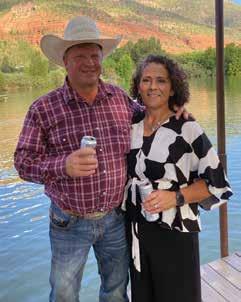

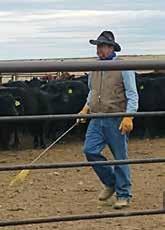


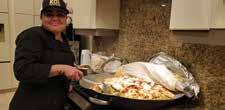

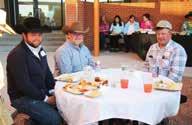

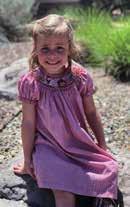
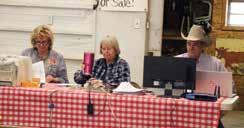
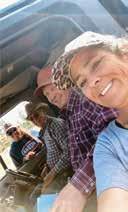
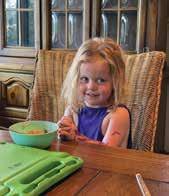

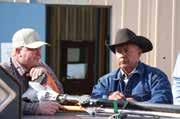

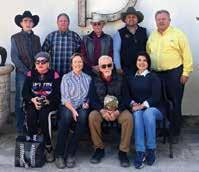
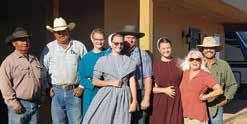




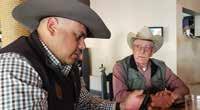
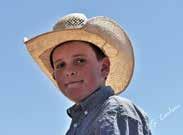
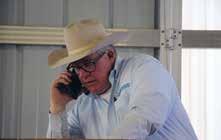
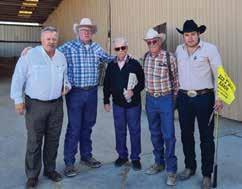
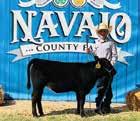
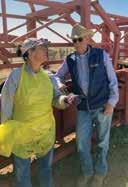
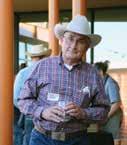
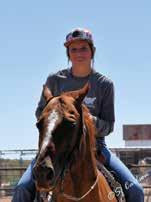
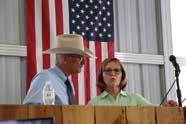
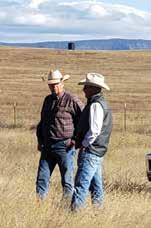
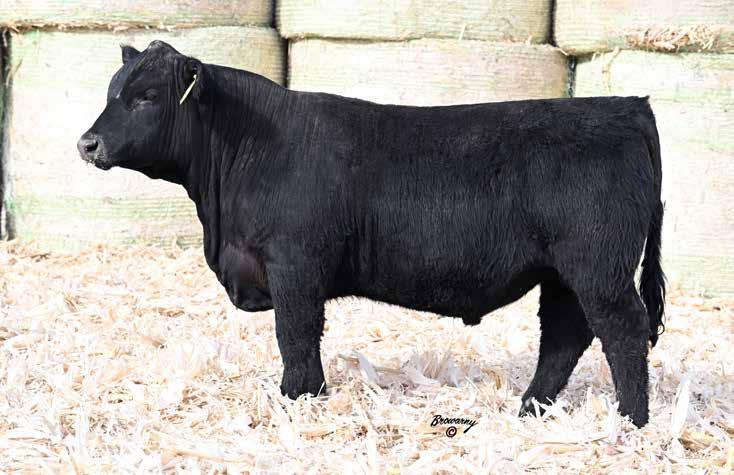

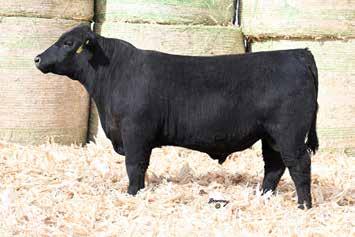


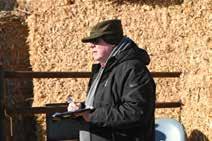


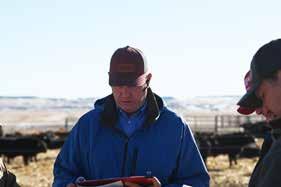
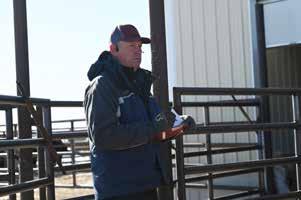
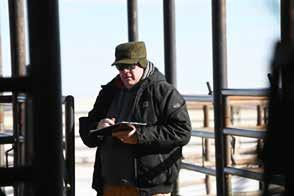
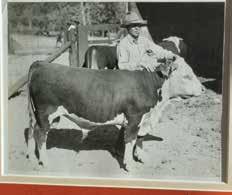
Judy Prosser’s grandfather, Boss Chilson, pictured with with one of the Carload of bulls they purchased at Denver in the early 40’s. He was born in 1876.
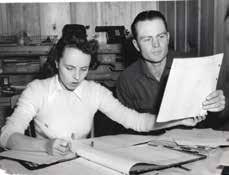
Ernest and Evelyn Chilson in the early 1950’s in the office at Crater Ranch.
1913
Boss Chilson (Judy’s Grandfather) had holdings in Tonto Basin.
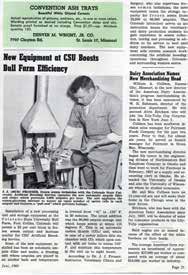
Bud Prosser with new frozen ampule machine before starting IBB with Mac Cropsey
Bob & Judy Prosser met working at the AICA.
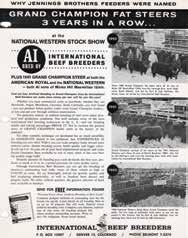
1964
1940
Sold holdings in Tonto Basin and acquired Pitchfork Ranch near Winslow
1960
1924
Boss Chilson acquired holdings at Double Circle on the Mogollon Rim. Cattle were trailed every year from Payson to Double Circle a 60-mile trek.
1950’s
Added a Registered Hereford herd
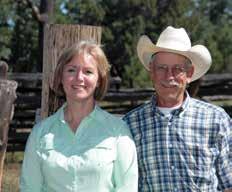
IBB flyer promoting AI sired Champion Steers 3 years in a row owned by Clayton Jennings .
Ernest Chilson (Judy’s father) began performance testing the registered Hereford herd.
Bud Prosser (Bob’s Dad) and Mac Cropsey built International Beef Breeders an all Beef Semen collection facility in Broomfield, CO.
1962
Bud Prosser believed in crossbreeding. He promoted this at IBB by offering Dwarf-free Beef semen.
1980
1985
Moved to Bar T Bar Ranch aging the Registered Hereford and introduced Angus, Charolais, Gelbvieh to the breeding program.
MARC released Clay Center’s Phase II Germplasm report highlighting the pounds weaned per cow exposed advantage of Gelbvieh Cattle.
1979
Bob & Judy meet working for the American International Charolais Association
1981 Married
The Market a sales and bull company



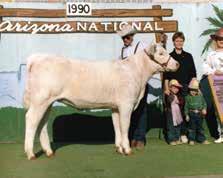
Judy, Bob, Spencer, and Warren with a Charolais heifer they raised.
Learning, Improving and Advancing the Family Legacy A Century
Co. manHereford herd Charolais, and program.
2008 was a Bar T Bar Ranch Reunion celebrating 70 years of operation with 3 of the 4 generations represented.

1998 (to Present)
The 1st or 2nd largest producer of Dams of Merit or Dams of Distinction in the US
1992
Fully committed to Composite bull program utilizing Balancer (Gelbvieh x Angus) genetics
2010
Southern Balancer recognized as a breed. Industry Excellence with a touch of ear.
2006
Awarded USFS National Rangeland Stewardship Award and Region 6 NCBA Stewardship winner.
2017
Awarded Range Manager of the Year by Arizona SRM. Bob was awarded Cattlemen of the Year by Arizona Cattlegrowers’ Association.
2011
Bar T Bar & Flying M Ranch awarded BEEF magazine's Trail Blazer Award for our work with Diablo Trust
Married and started Market Company management bull development company

2025
Celebrating 100 years ranching on the Mogollon Rim.
Received the Country Natural Beef Award for the Most Profitable Lot of Cattle in the Rocky Mountain Region.
Balancer recognized as a breed
1991
With the help of Ernest Chilson, Prossers purchased Bar T Bar Ranch.
Started selling our commercial cattle through Country Natural Beef and collecting carcass data
2002
Implemented Ultrasound Scanning for Carcass traits and PAP testing.
2015
Installed Growsafe Feed Efficiency Testing System at headquarters and held first bull sale on the Ranch
2011
Began Individual Feed efficiency testing the bulls and held our sale in Nevada at Snyders’
2022
Developed an advisory board for the ranch to include family and Chuck Phillips, Duane Coleman, Tom Field and Burke Teichert.
We appreciate our customers!
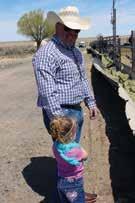
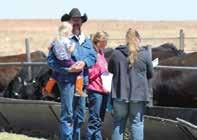

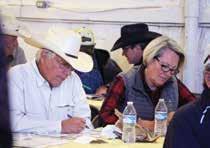
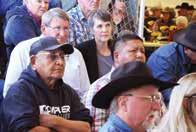
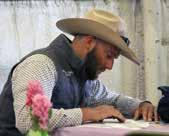

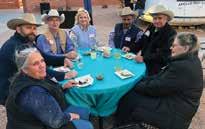
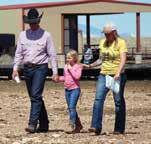
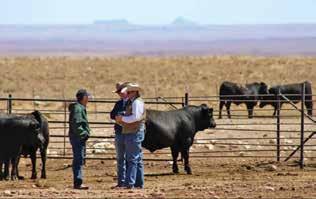
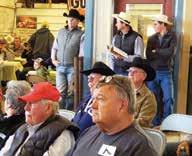
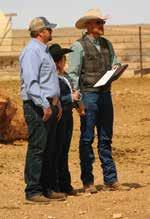
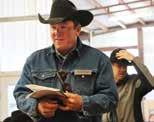
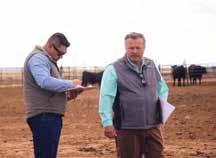
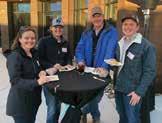
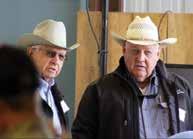
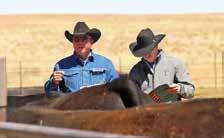

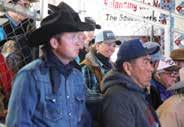
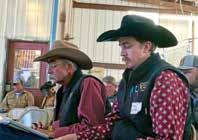
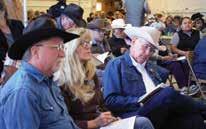
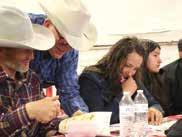
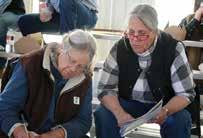


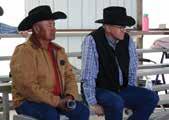
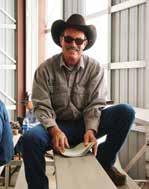

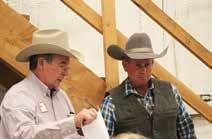
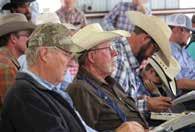
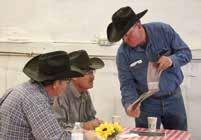
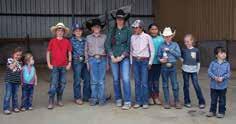

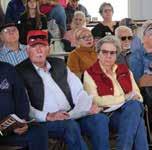
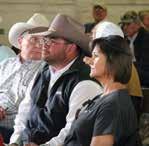
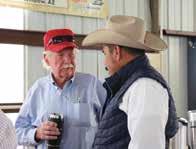
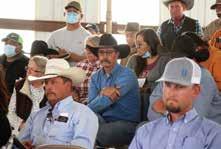
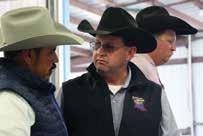

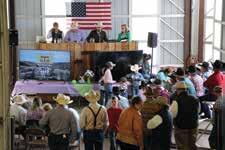
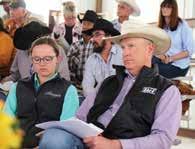
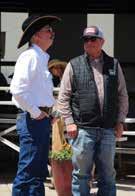
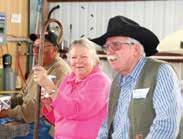
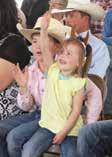
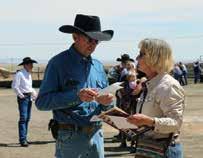
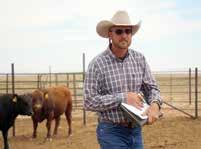
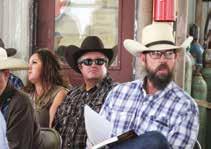

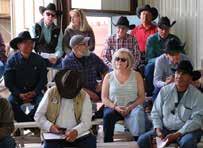
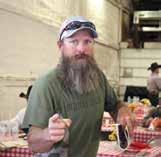
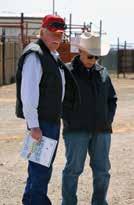
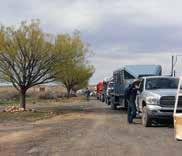

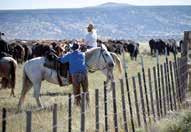
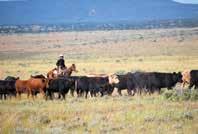
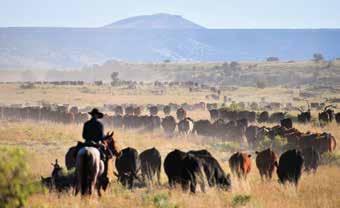
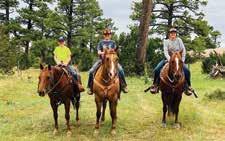
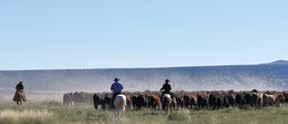



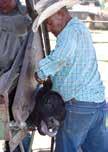

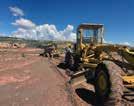

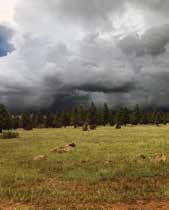
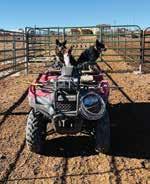
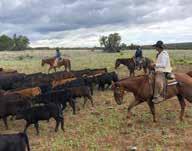
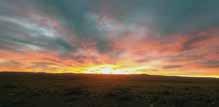

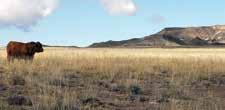
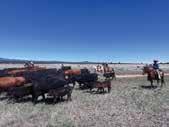
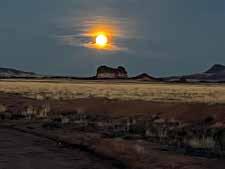
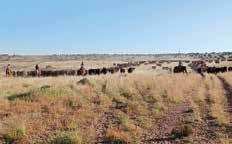



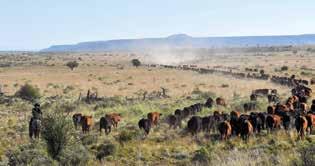
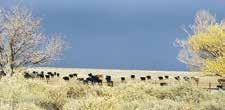

We know from our own cowherds that losing calves to brisket at any time from birth through yearling stage can have significant financial cost. We are convinced that pulmonary artery pressure (PAP) scores are very strong predictors of whether or not animals will have the disease. For this reason, we have collected over 9,133 PAP scores on cattle in our program.
Unfortunately, taking measurements will not solve the problem. Most ranchers know that buying PAP tested bulls reduces the problems with brisket, but most still report losing 3% - 8% of their calves to brisket depending on the year. This level of calf loss is still unacceptable!
We believe that the best strategy to reduce brisket disease is to use genomically enhanced expected progeny differences (EPDs) for PAP. Think of selecting for low birth weight. Just buying bulls under 80 pounds would help calving ease, but using low birth weight EPD bulls is a much more effective strategy. This is true, because an EPD takes into account much more information. For example, buying a 75 lb. BW bull out of a sire that generally sires very heavy calves is far less likely to be easy calving than is a similar BW bull out of a sire that generally sires light calves. The same is the case with PAP.
Our PAP EPD closely relates to the actual PAP score of the bulls as shown in the graph below. The correlation between the PAP scores and the PAP EPDs are 85%. This is typical in a trait like PAP that is 30% heritable. However, as with all EPDs, you can see that some bulls score better or worse on the EPDs than on the actual score. Ranchers concerned with PAP scores should use the EPDs – not the actual PAP scores.
Key points regarding PAP and PAP
• We have taken 9,133 PAP scores (all by Dr. Tim Holt).
• PAP is 30% heritable.
• The PAP EPDs reported were calculated by Zoetis. They include information related to the genomics of the bulls. This increases the accuracy of the prediction, even without a PAP test.
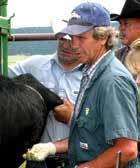
• Selecting bulls using the PAP EPD is FAR more accurate than simply using the PAP scores.
• Herds that have significant brisket disease should use the lowest PAP EPD bulls.
AGE: Yearling Yearling 18 months + ELEVATION: 6,000 ft. and lower 7,000 ft. and higher 8,000 ft. and higher
Low Risk 41 and lower 42 and lower 45 and lower
Moderate Risk 42 to 48 43 to 48 46 to 51
High Risk 49 and higher 49 and higher 52 and higher
and
0.0 and lower Little to no loss
-0.7 and lower Improve herd
Bar T Bar guarantees any bull that we PAP at 40 or lower before the sale, to PAP 45 or lower at 8000 feet in the fall.
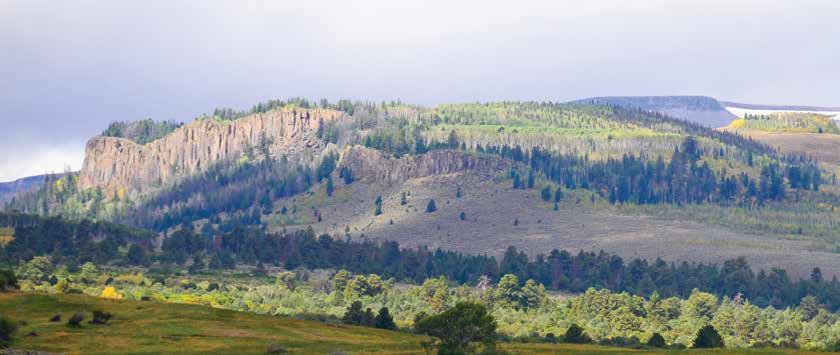

INHERIT ® Select™ provides genetic insights that help build on the strengths of your commercial herd.

See the results in the field, not just on paper
Save time and resources by getting accurate insights on a heifer’s potential in a matter of weeks, rather than waiting years to track her performance.

INHERIT Select is a genetic testing tool for commercial females that delivers insights you can trust. Informed genetic decisions can help lead to:
Longer lasting, more efficient and profitable cows
Fewer headaches when calving
Better calves on the ground, with efficient growth and more carcass merit
Buying better bulls and better mating decisions
Accentuating herd strengths and correcting weaknesses
Optimizing breed composition and hybrid vigor
Better information helps consistently achieve goals
It’s amazing what a small tissue sample can unlock, providing you with more dependable information than instincts alone. It’s how INHERIT Select can help you consistently build a cow herd with lower costs, better reproduction rates and higher-value calves.
1.4 million straightbred and crossbred animals¹ Predictions for crosses of 8 major breeds Rankings according to 20 traits
3 easy-to-understand economic indexes
Scan here or visit BeefGenetics.com to schedule a meeting and get started with genetic testing.




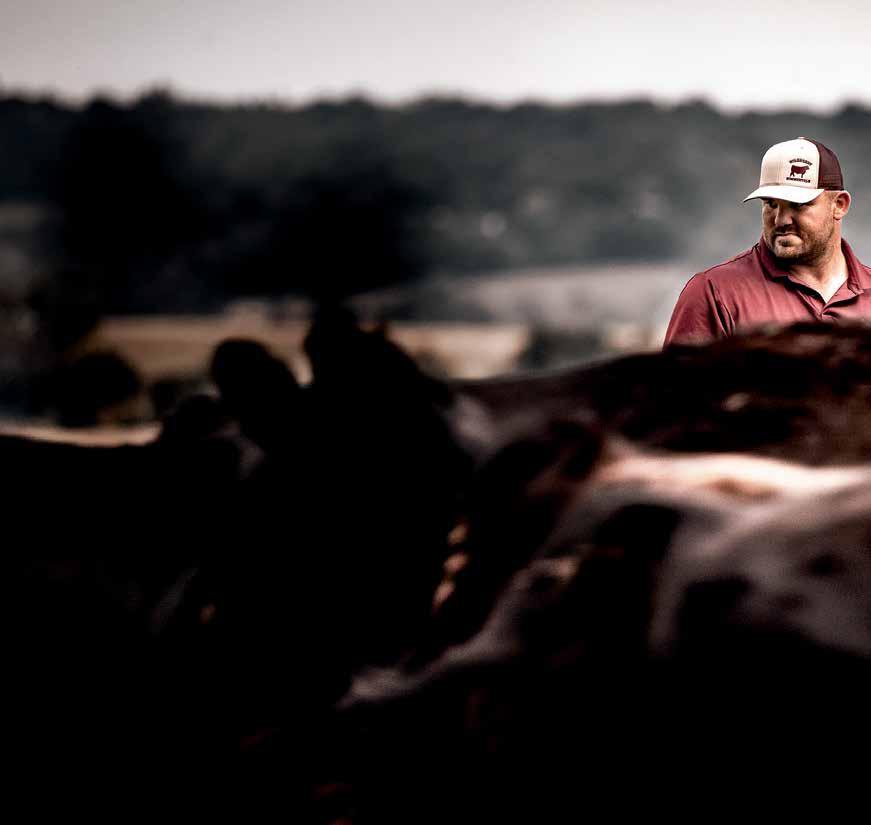






You know how to raise them. We know how to sell them. We’ve been working for cattlemen like you since 1987.
Consign in an upcoming video auction to take advantage of current market conditions and expose your cattle to a nationwide buyer base of more than 6,500 active buyers ready to compete for your cattle. This gives you the opportunity to utilize the auction method of marketing, while maintaining control of shrink and stress, helping to improve your bottom line.
America’s Livestock Marketing Leader - Working for You.



Superior Productions is powered by Superior Livestock Auction, and is your purebred auction live streaming partner. Market your purebred sale to Superior’s commercial cattlemen buyer base. Take advantage of our advanced clerking system and manage your buyer database. Superior Productions was designed by cattlemen, for cattlemen.
Contact our team at Superior Productions to book your next live stream.
Superior Livestock Auction (800) 422-2117 3320 E Interstate 20 Hudson Oaks, TX 76087







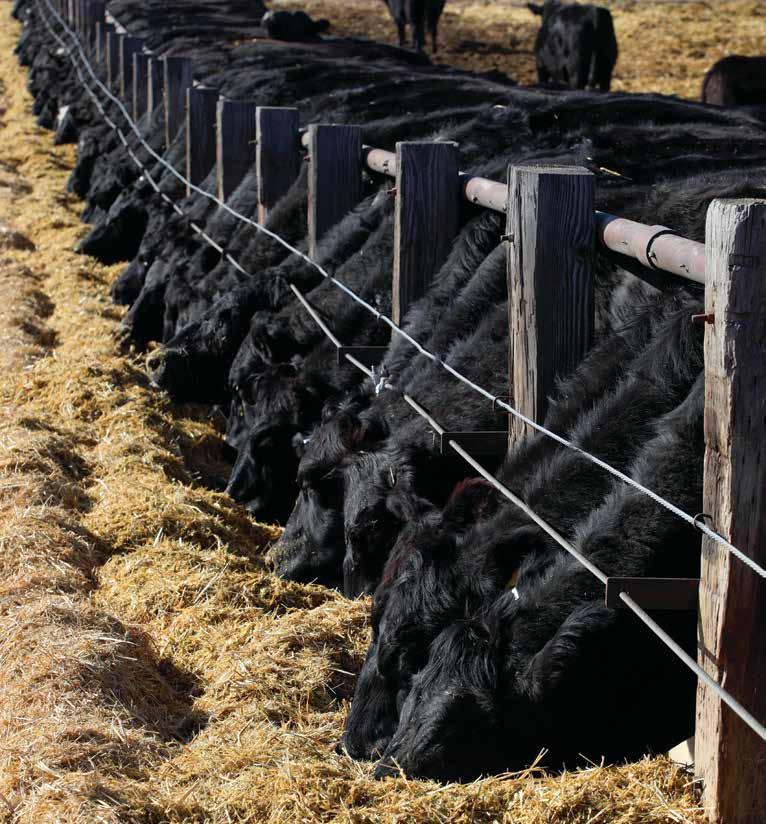



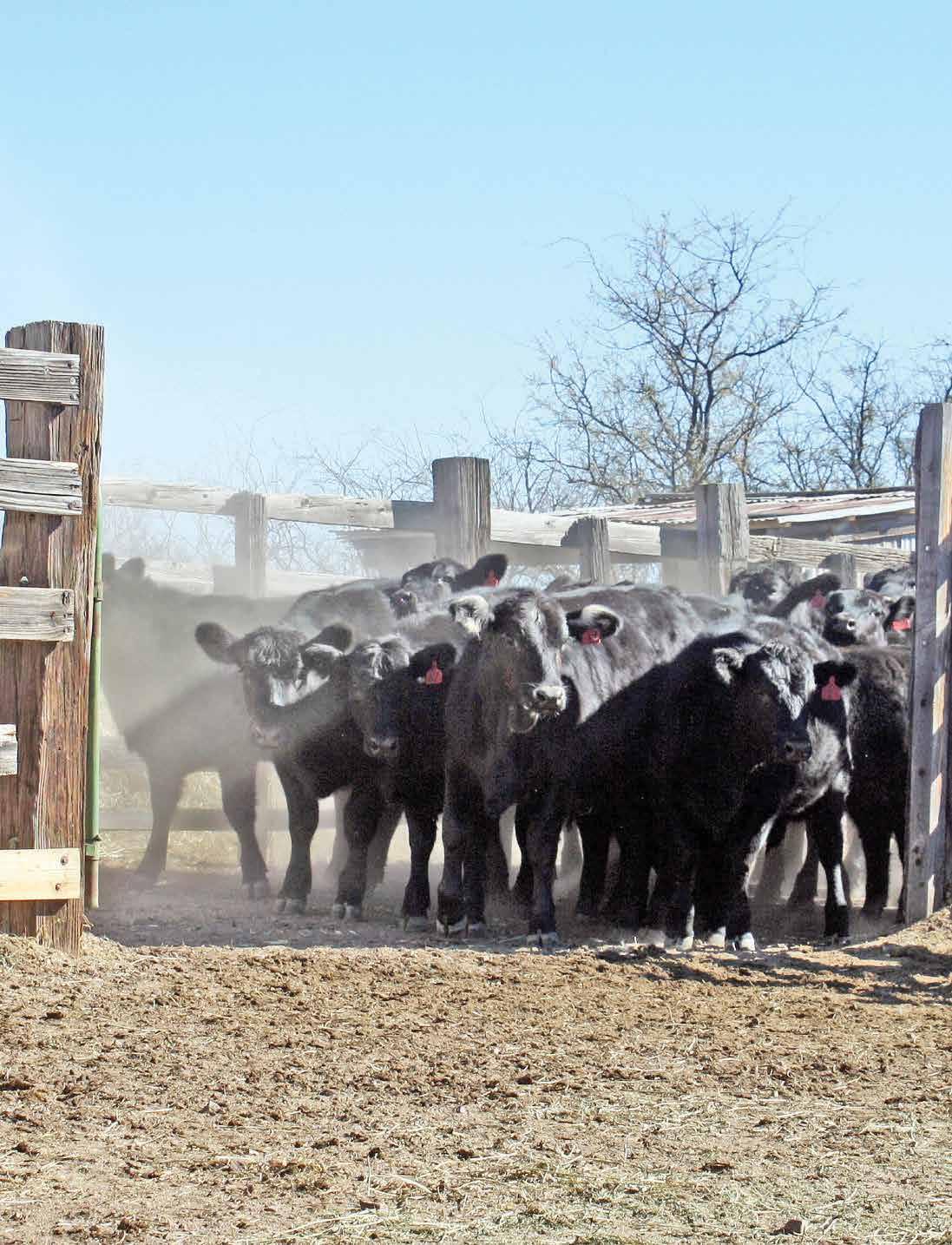
NEW: Cost effective technology you can use at your ranch; Vaccines, Wormers, BVD-PI Snap Tests, Pregnancy Tests.
EXPANDED: Our Farrier Supplies section - all the shoes, tools, etc.
ATTENTION: We pride ourselves on our knowledgeable, friendly service. We pay attention to You, and work hard to earn your trust.
LOCATION: We are located in Arizona to serve you faster and better.
Orders placed by 3 pm MST ship the same day!
Locally owned and managed since 1990 by Tim & Barbara Jackson.



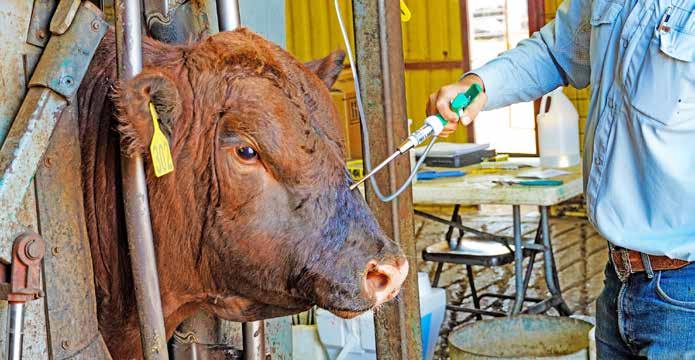
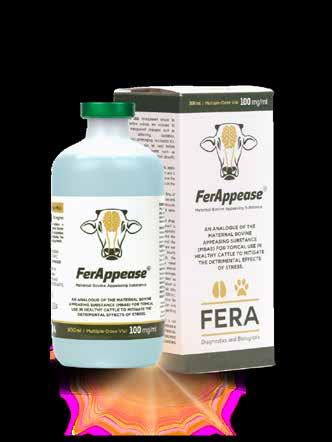


We have 42 bulls from four different locations all blended together for the first time. We treated them this morning and they aren’t fighting or riding, they are going to feed and commingling better. FerAppease is a fabulous tool. “
- DONNELL BROWN, RA BROWN RANCH
Treat your calves, cows, and bulls with FerAppease for even temperament, reduced stress, and increased profitability.
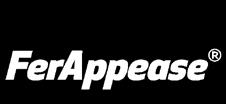

In a world of increasing challenges, Halter stands out as the product helping ranchers run more productive and sustainable operations
• Increase productivity and weaning weights
• Significantly reduce fencing costs and maintenance
• Flexible grazing management with virtual herding

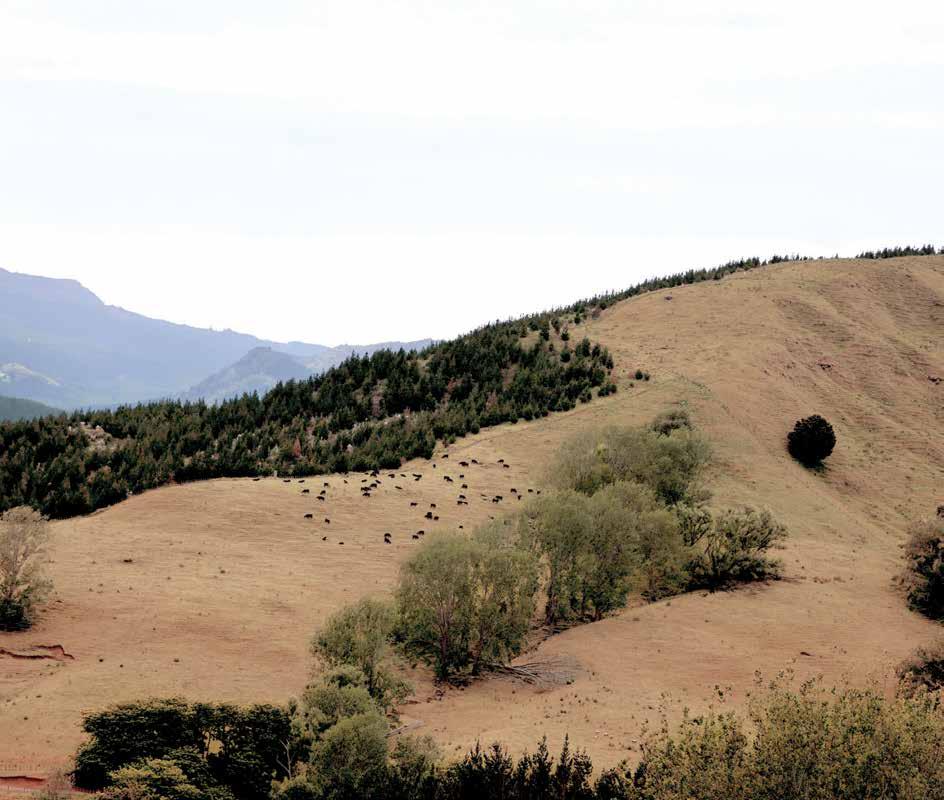
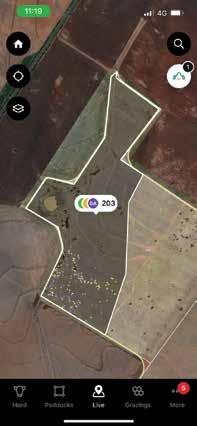
The collar
The lightweight, ergonomically designed collar transmits cattle data 24/7.
The tower
Transmission towers send data between the collars and app. No cell coverage required.
The app
The easy-to-use mobile app lets ranchers remotely manage and shift mobs, optimizing grazing & feed management with virtual fencing.



Tucson « Sonoita « Cottonwood « St. Johns
“Serving Arizona Agriculture”
Designated Broker - Walter Lane
An Arizona-owned company providing service to Arizona agriculture for over 42 years. We have professional knowledge and experience to help you. We can sell your property - Call for listing information.
AVAILABLE - NZ Milky Ranch
• - 450 AU including 37,518 deeded acres with an additional 7,680 acres of Arizona State grazing lease located between Holbrook and Saint Johns, Arizona. The ranch is located directly off of US Highway 180 including seven miles of highway frontage. All access to the ranch is via private property and is contained behind locked gates provide one-of-a-kind privacy and vast views of the National Park. Also included is an additional 7,270 deeded acres located outside the ranch fence of development property. Price: $14,000,000 - Traegen Knight.
AVAILABLE - Hay Hollow Ranch
• - 19,458 deeded acres located between Holbrook and Snowflake, Arizona along the Little Colorado River. Stunning views of painted desert scenery accessible by County roads yet great privacy and the feeling of seclusion. This could be a great investment or development property for solar, wind or residential use. Price: $6,500,000 - Traegen Knight.
AVAILABLE - Hay Hook Ranch
• - Roosevelt Lake area ranch. This is one of the best watered ranches we have ever seen with 27.5 +/- miles of pipeline to 59 troughs and 6 storage tanks, the ranch’s 231 AU permit is fully stocked and sits on two PRF grids in Gila and Maricopa Counties, there is also a 172 head yearling carryover allowed for 5.5 months. The 19.24 deeded acres has highway frontage with home, barn, corrals, roping arena and a 17 space mobile home/RV park. - $2,250,000 - Paul Groseta
AVAILABLE - Poco Toro Ranch
• - Patagonia - 379 deeded/300 USFS; 8-25 head - $2,420,000 - Sam Hubbell
ESCROW - Montana Allotment
• - The Montana Allotment is a solid 400-500 head cattle ranch in a beautiful part of southeastern Arizona. The ranch has been carefully managed by the same owner for many years. Contact Walter Lane ESCROW - Tres Alamos & Pipeline
• - 73,165 total acres (333 deeded)/561 AU - Yavapai County - W of Congress, NW of Wickenburg - $2,500,000 - Paul Groseta
ESCROW - Triangle M Ranch
• - Horsethief, Blue Bell and Wolf Creek allotments - 51,012 total acres (62 deeded), 208 AU YL + 50 AU 8 months - $3,000,000 - Andy Groseta
SOLD
• - CV/CF Ranches - Northwest of Prescott with 28,554 deeded acres and 20,590 ASLD acres, 669 head cattle ranch with 929 historically irrigated acres - Paul Groseta
SOLD
• - Little Colorado River - 10,215 acres (1,649 deeded), 200 AU yearlong - Sprinerville - Traegen Knight
SOLD
• - Skully Creek -8,500 acres (1,440 deeded) 40 miles NE of Safford in Greenlee County. 94 AU. 1,900 sq. ft. home overlooking Skully Creek Canyon. - Traegen Knight
SOLD • - Indian Springs - 52 AU with 1,480 deeded acres & BLM grazing lease in Cochise County approximately 14 miles northeast of San Simon, Arizona. - Traegen Knight
SOLD • - Three Links - Legacy ranch that runs over 1,300 head on 19 sections of deeded land and 135 sections of state lease in some of Arizona’s best cattle country. The highly improved ranch headquarters also has a 1,200 head feedlot for weaning calves off the ranch to start pre-conditioning and backgrounding. - Andy Groseta
SOLD • - Tombstone Ranch - 21,060 acre (7,060 deeded) acre ranch just E. of Tombstone - 320 AU - Sam Hubbell
Sonoita St. Johns Tucson
Andy Groseta
Paul Groseta
PO BOX 1840
51 Verde Heights Dr., A
Cottonwood, AZ 86326
P: (928) 634-8110
F: (928) 634-2113
Sam Hubbell
Sandy Ruppel
Dede Mikowski
PO BOX 1039
Sonoita, AZ 85637
P: (520) 609-2546
Traegen Knight
PO BOX 1980
St. Johns,AZ 85936
P: (602) 228-3494
Walter Lane - DB
Trey Champie
PO BOX 37018
Tucson, AZ 85718
P: (520) 792-2652
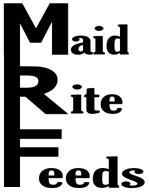


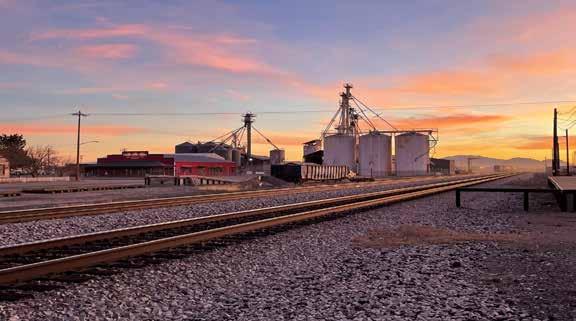


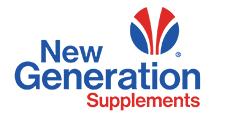


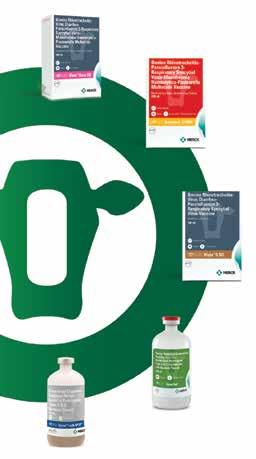
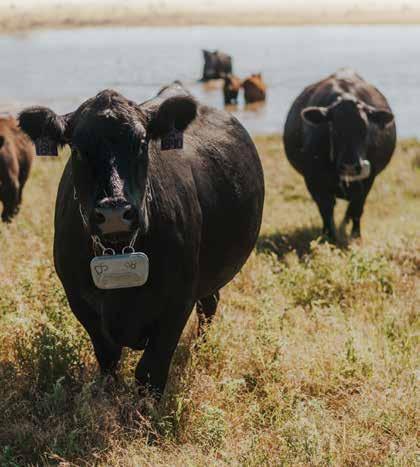
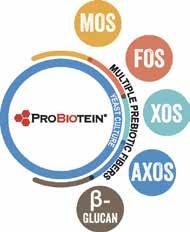
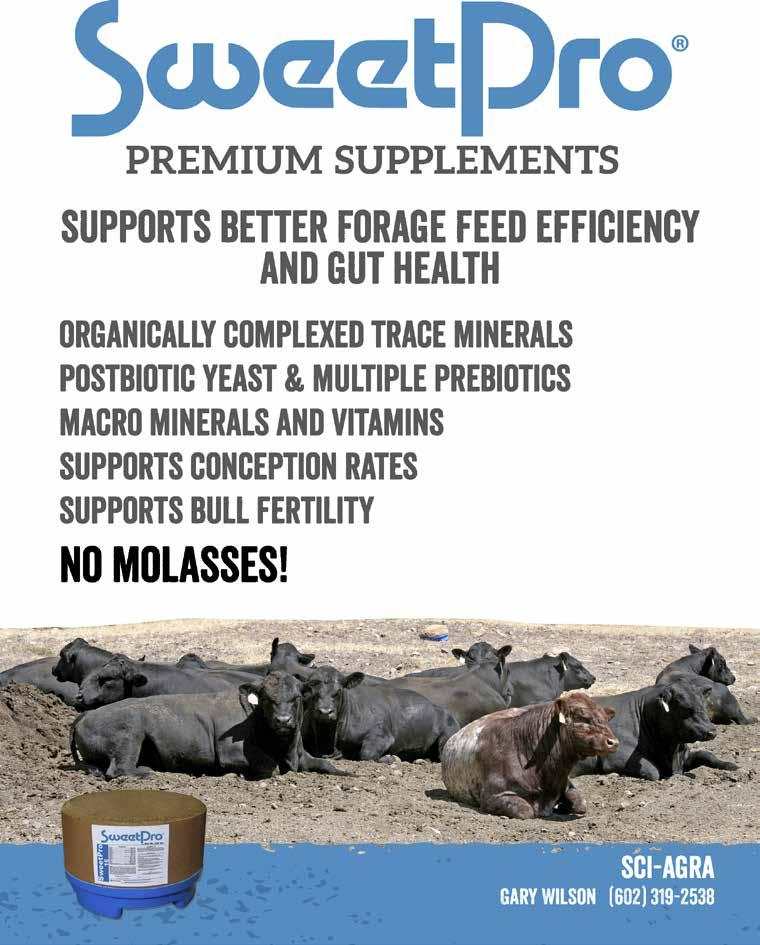



Keep your cattle hydrated with real-time alerts on water levels, leaks and more with Ranchbot.
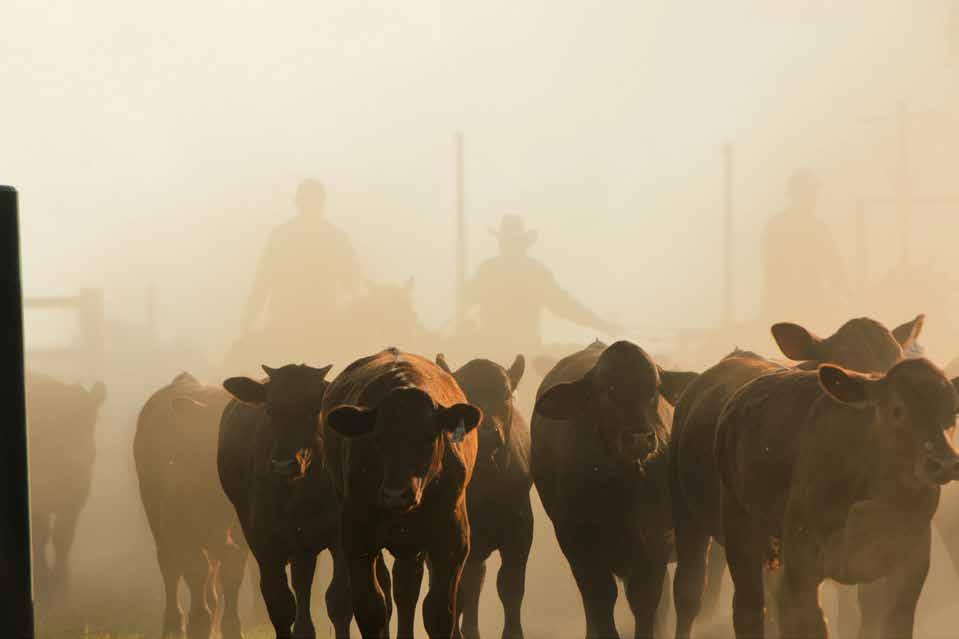
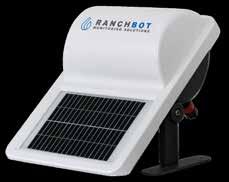




$2,000 VOLUMEBUYER GETS *
*$2,000 credit towards any Ranchbot product or subscription Volume Buyer can maximize efficiency and take control of water management with this exclusive offer.
No service? No worries. 24/7 satellite connectivity.
Operates on its own. No additional devices required.
Business Development Manager
Jake Woehlecke| 520-631-5253
Jake Woehlecke@ranch-bot com
Lifetime support from the Ranchbot team



